One Day Kyoto Itinerary: Must-Sees and Must-Dos
Our one day Kyoto itinerary was by far one of the best things we’ve done in all of our travels so far.
But first, I have to admit that it was my teen daughter’s insistence that led us to visit Japan when we did. I have been longing for my first visit to Asia. (Yes, I’ve been to Dubai, but it didn’t feel very Asian to me. No matter what Google says!) But, there were a few countries in the area that I was equally excited to explore.
But, for a couple of years now, my daughter’s been calling Japan her favorite country – despite never having been there!
So, Japan it was.
Why One Day in Kyoto?
And once we made the decision to go, I just KNEW our 6 day Japan itinerary had to include Kyoto. The city of ancient temples, serene gardens, UNESCO World Heritage sites, and over 400 colorful shrines were an absolute must.
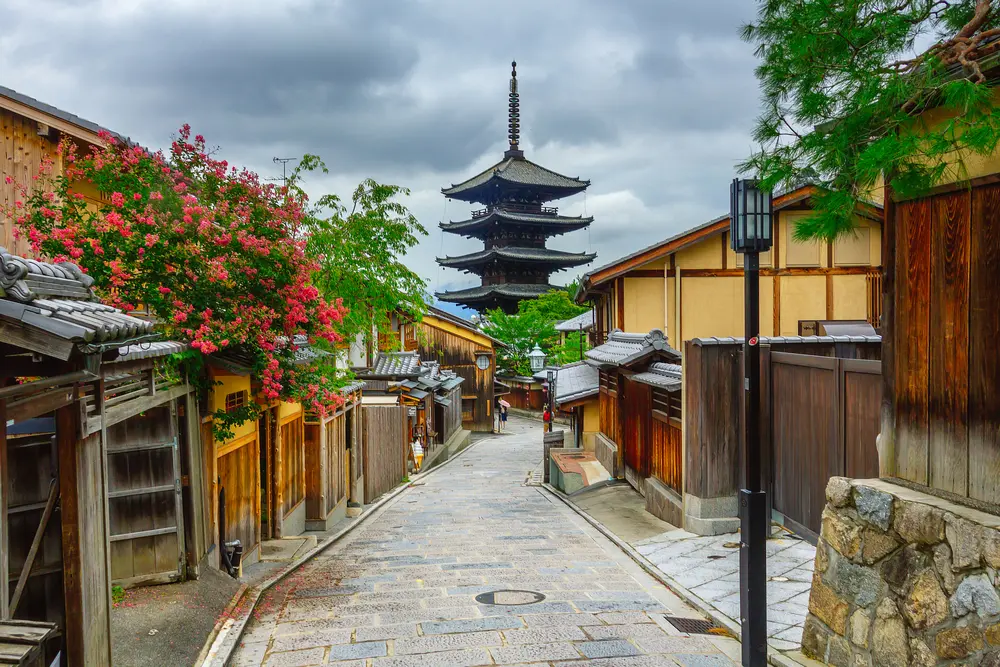
One concern we had was – since we only had a week, and since Tokyo, where we would be based, also had so much to see and do – how we could fit Kyoto into our trip and do it justice.
Well, it took a bit of figuring, but, with the help of a very knowledgeable tour guide, we were able to create a full, culturally-rich day in Kyoto, Japan.
We were happily surprised to find that one day, morning to night, was actually enough to capture the essence of this stunning city.
In this post, I hope you find an itinerary that you can use to explore some of the best of Kyoto, even if you only have one day to spend.
NOTE: Everything included in this itinerary is totally doable on your own. However, as we were in Japan for our very first trip, neither of us spoke the language and it was a full day trip to an entirely different part of the country that included navigating train transfers on both ends, we were a little bit nervous to do it on our own.
So we hired a personal guide from GoWithGuide.com, and that was the perfect choice for us.
Our guide picked us up at our hotel in the morning, traveled with us to Kyoto by train, and helped us navigate all aspects of our visit.
He shared historical and cultural information we wouldn’t have had if we went on our own and BONUS, he took pictures of us so we could both be in them at the same time. 😄
At the end of the trip he traveled with us back to Tokyo and back to our hotel. It made an incredible experience even better because we didn’t have to feel nervous about getting lost or misunderstanding anything and because he was so knowledgeable we learned so much more than if we had done it on our own.
If having a guide is part of your travel style, then I highly recommend GoWithGuide.com.
Traveling to Kyoto
Our adventure began bright and early at 8 am from the Tokyo neighborhood of Shinjuku.
And honestly, we were excited for our trip from the moment we woke up! In addition to the Kyoto experience itself, we were also thrilled that the trip would allow us to use the famous shinkansen or “Bullet Train” to start (and end) our journey.
By car, traveling from Tokyo to Kyoto could take 7 hours. Fourteen-plus hours round-trip is more than we could spare on such a short visit to Japan. Plus it really would require us to stay the night in Kyoto. With a jam-packed Japan itinerary, we just couldn’t afford it.
With the shinkansen Bullet Train, we were able to cut our travel time to less than 3 hours each way, giving us maximum time in Kyoto.
Note: Shinjuku was an ideal place to stay while in Tokyo since, among other things, it is home to the most connected train station in all of Tokyo. Shinjuku Station truly is a transportation hub, and we utilized it multiple times while in town.
From our hotel, Keio Plaza Hotel, Tokyo, it was an “easy” 10 minute walk to the train station. I put ‘easy’ in quotes because in terms of distance, it definitely was. But, I would say that Tokyo in June is not that easy when it comes to the weather. 😌 Even at a leisurely pace, we were half sweating by time we got to the station.
The Shinkansen Bullet Train
We took the train from Shinjuku Station to Tokyo Station, where we boarded the Bullet Train.
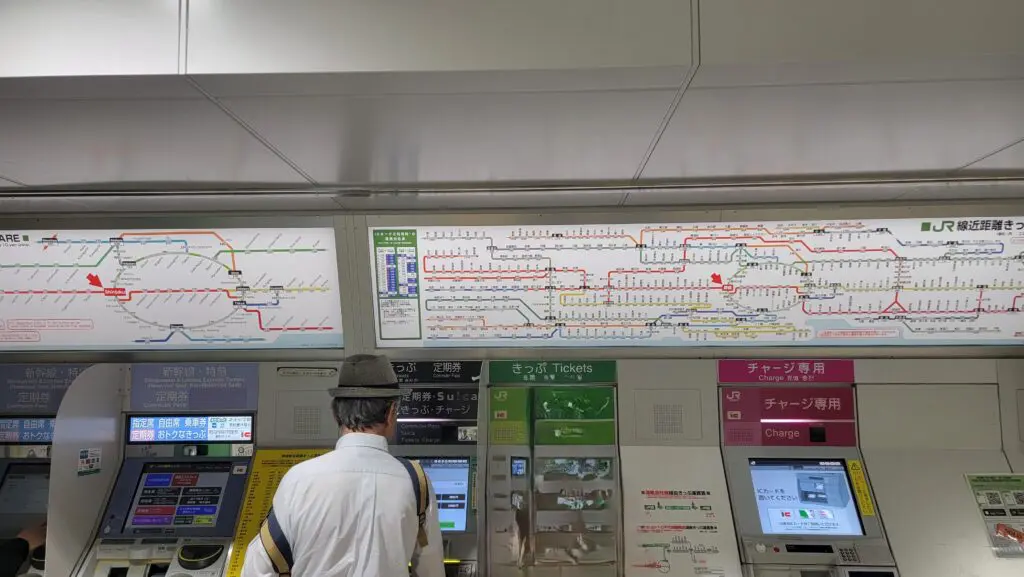
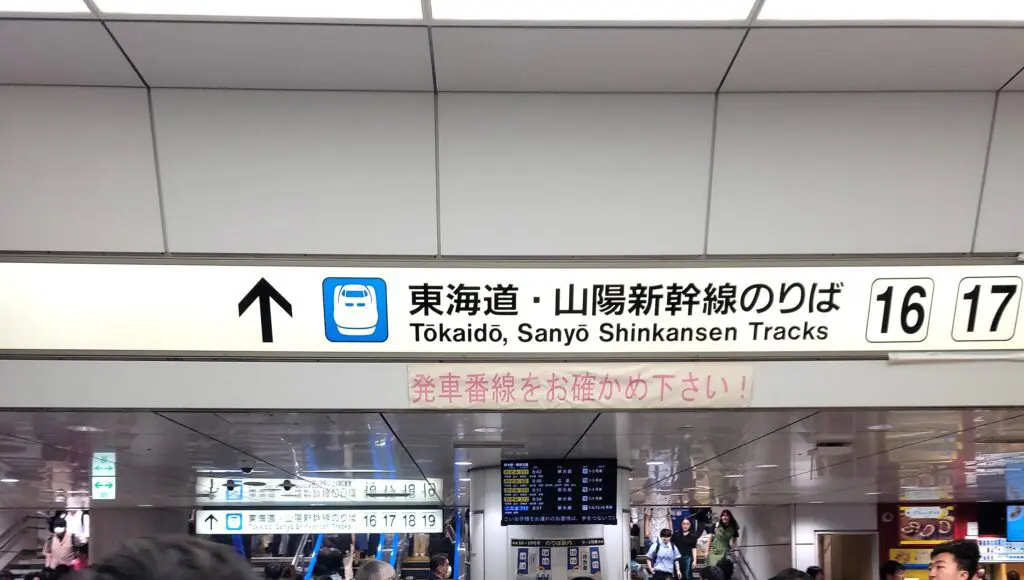
The Shinkansen, Japan’s famous bullet train, is renowned for its incredible speed, efficiency, and punctuality. Since its debut in 1964, it has connected major cities across the country, offering speeds up to 320 km/h (200 mph).
The network spans from Kyushu to Hokkaido, making travel easy and convenient. With cutting-edge technology ensuring safety and comfort, the Shinkansen is a reliable choice for commuters and tourists alike. Its punctuality is legendary, with delays rarely exceeding a few seconds.
Our guide had an app on his phone that showed us that the train we were on made it up to 170 mph. And despite that high speed it was an incredibly smooth ride. The seats had foot rests, and we ordered drinks and small snacks. All-in-all, it was an incredibly comfortable experience.
An additional benefit of taking the shinkansen was that we got to see Mt. Fuji, the tallest mountain in Japan. And it was breathtaking. As we were sitting on the right side of the train, we got a perfect view.
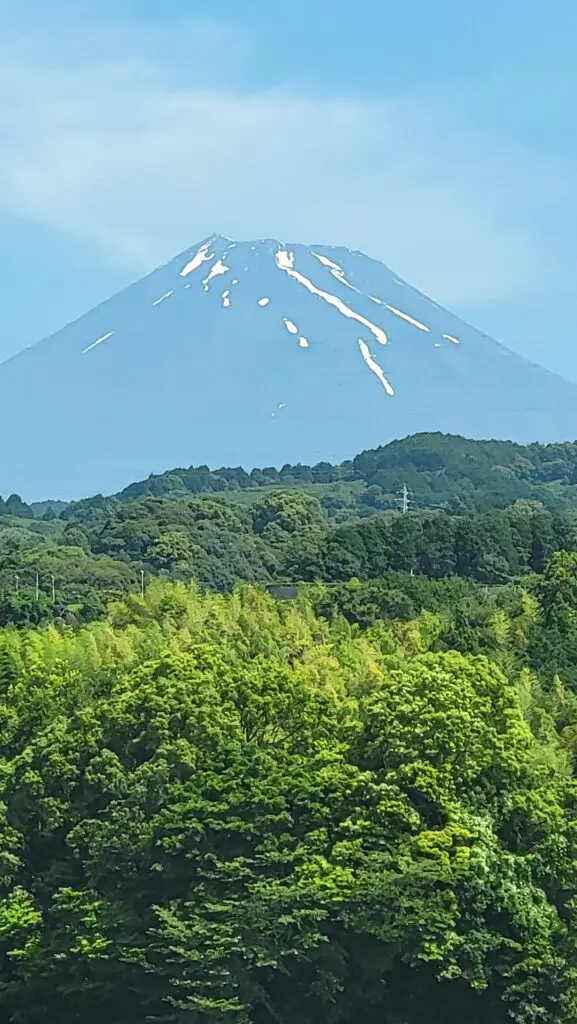
A couple of days prior, we had done an excursion specifically to see Mt. Fuji and Hakone, and this view from the train was as beautiful (if not more!) as the one we got from the 5th station of the mountain. While we were much closer during our excursion, it was a very cloudy day so we only got glimpses of the mountain. From the bullet train we had an incredible view.
NOTE: In order to get the seats that allowed us to see Mt. Fuji, we reserved our tickets weeks beforehand. I recommend you do the same!
Walking Through History at Fushimi Inari Taisha
Stepping off the shinkansen in Kyoto, we dove headfirst into the city’s history. We took a quick train ride from Kyoto Station to Inari Station. And our first stop was the Fushimi Inari Taisha, a Shinto shrine, dating back to 711.
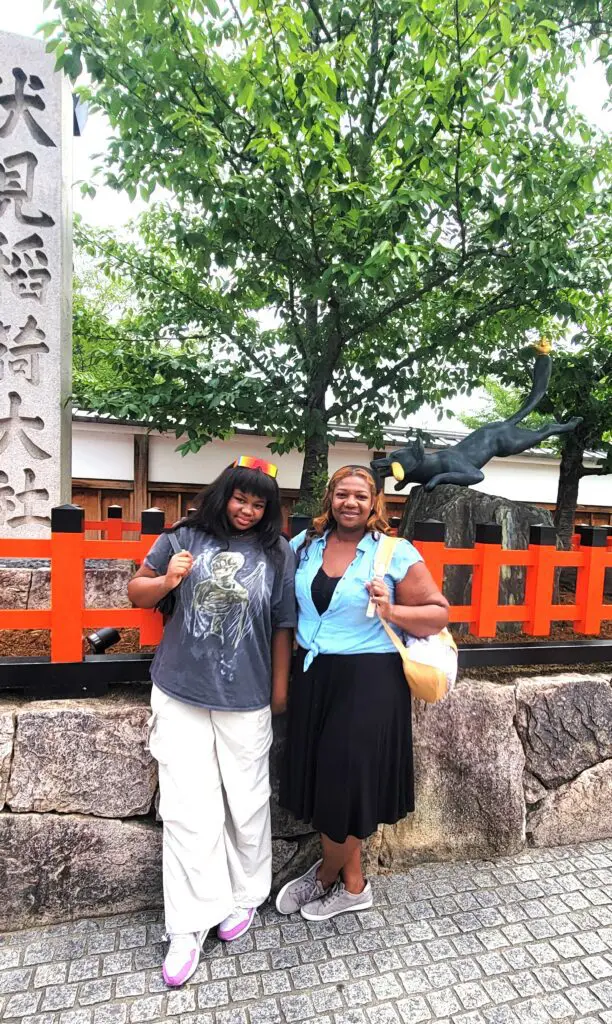
Fushimi Inari Taisha, located in Kyoto, is a must-visit Shinto shrine renowned for its thousands of vibrant red torii gates that form beautiful pathways up Mount Inari. Established in 711 AD and dedicated to Inari, the god of rice and prosperity, this shrine offers a serene hike through scenic trails adorned with symbolic fox statues.
Easily accessible from Inari Station, the shrine is open 24/7 and free to enter, making it a perfect destination for both tourists and locals.
The fox statutes you see in the picture above, and that you’ll see all around the shrine, are considered Inari’s messengers. Look out for them throughout the grounds.
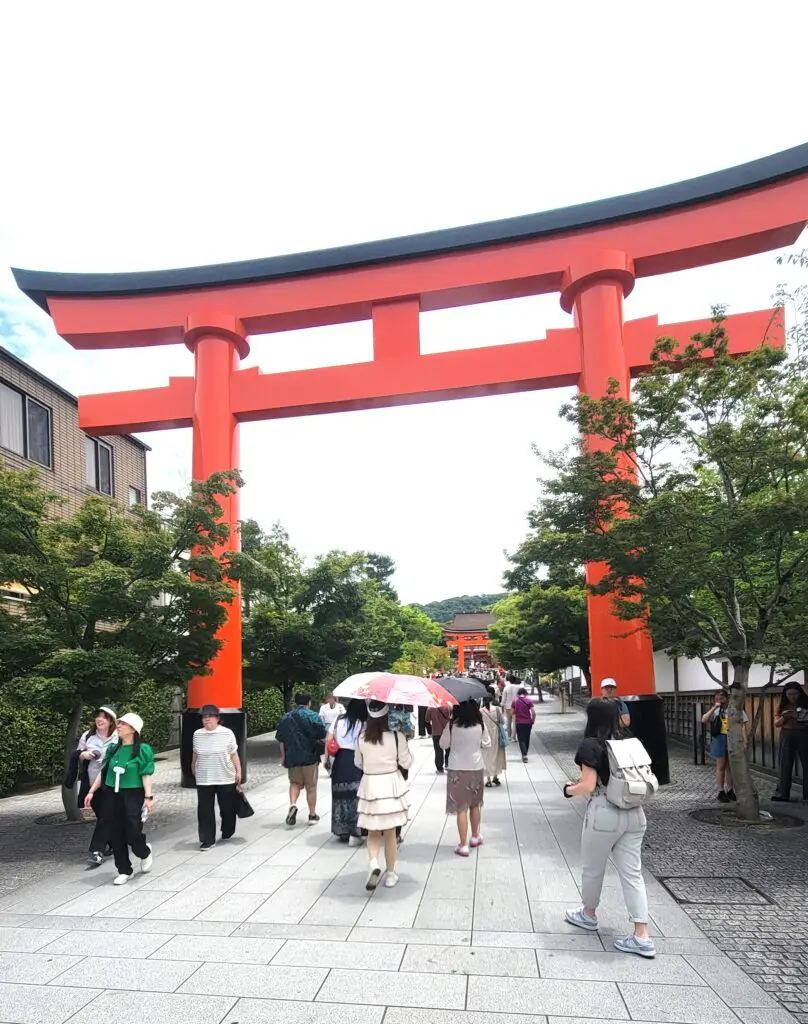
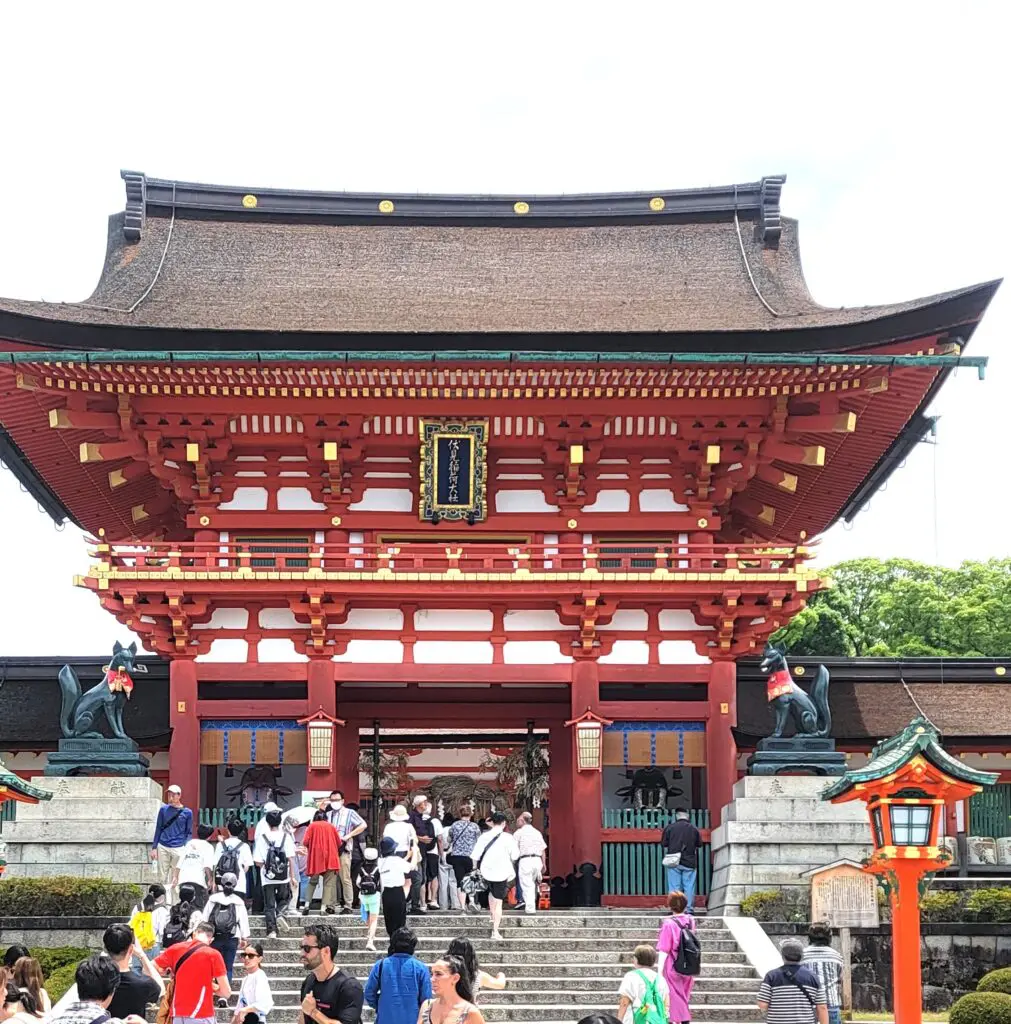
Once we walked beyond the main hall and onto the grounds, we found the famed torii gates. Each of these 10,000+ torii gates represents a donation from a believer. We spent some time walking through the gates. It was really fascinating to really feel like we were among believers.
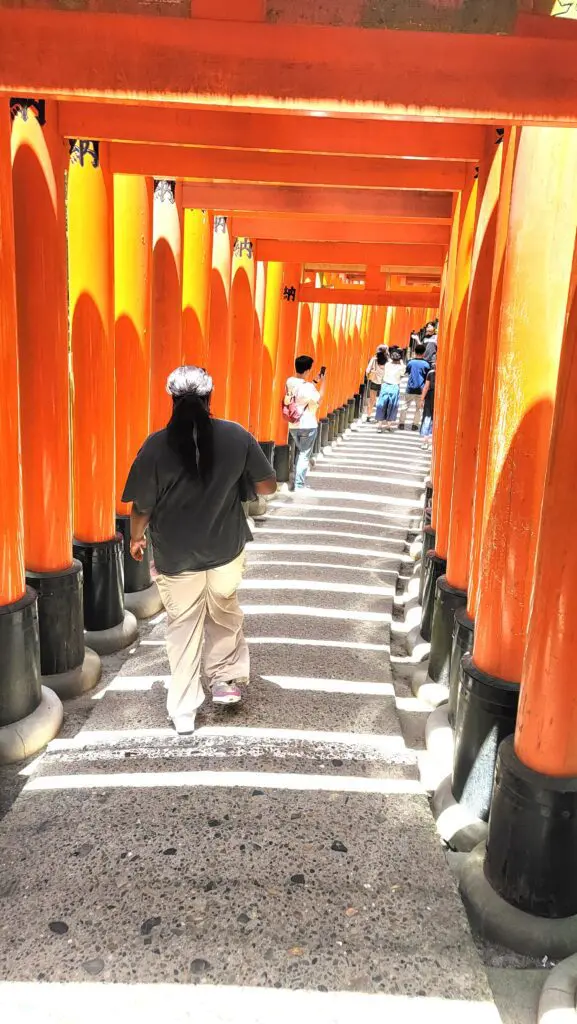
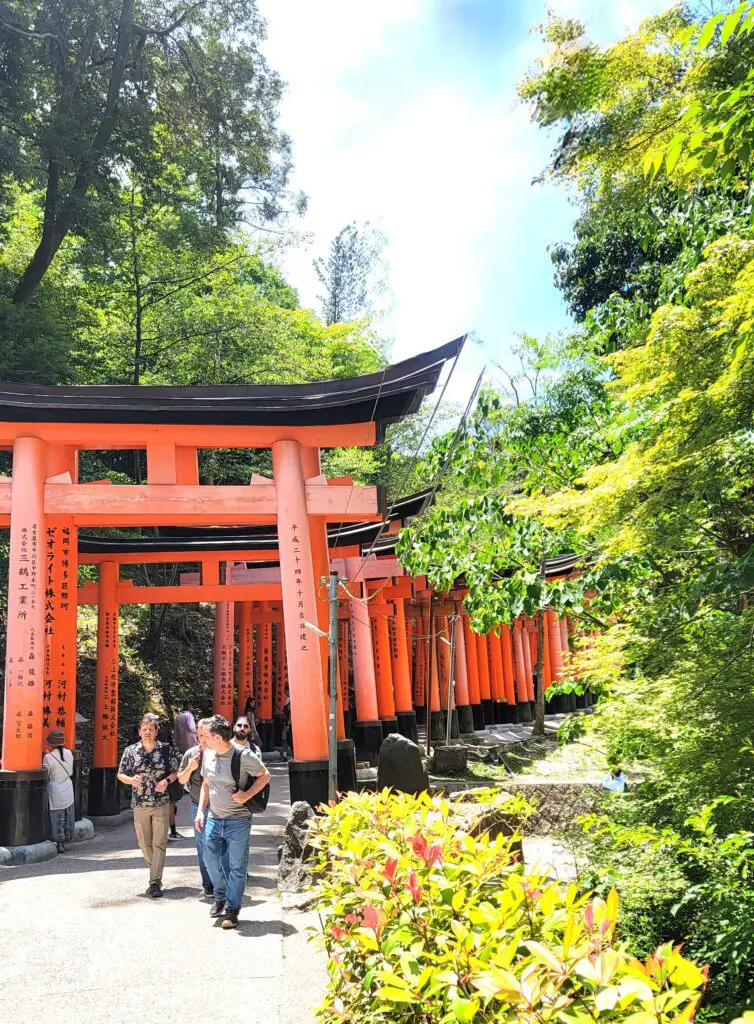
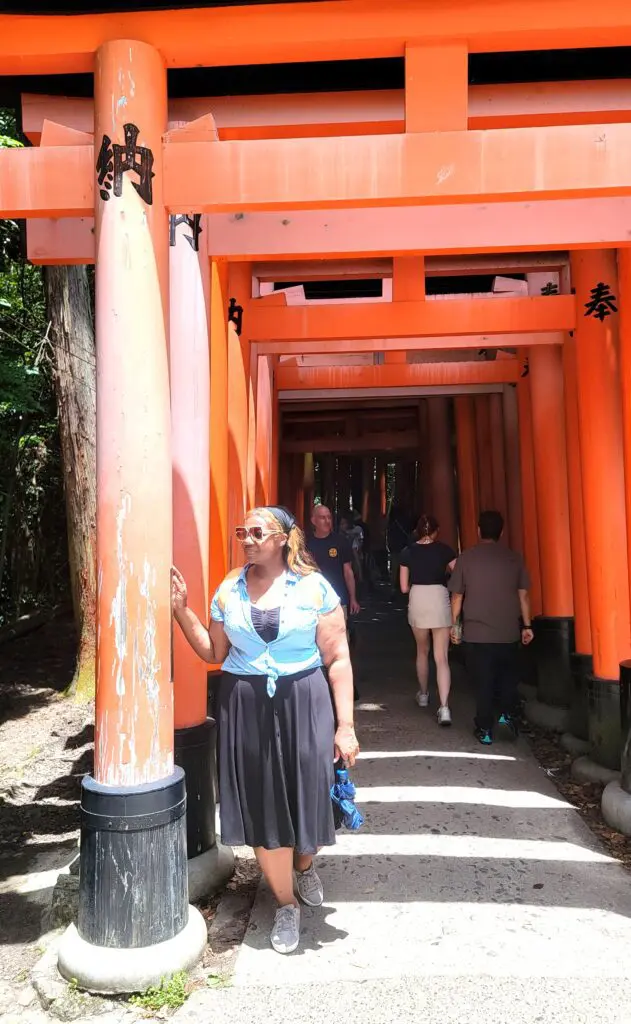
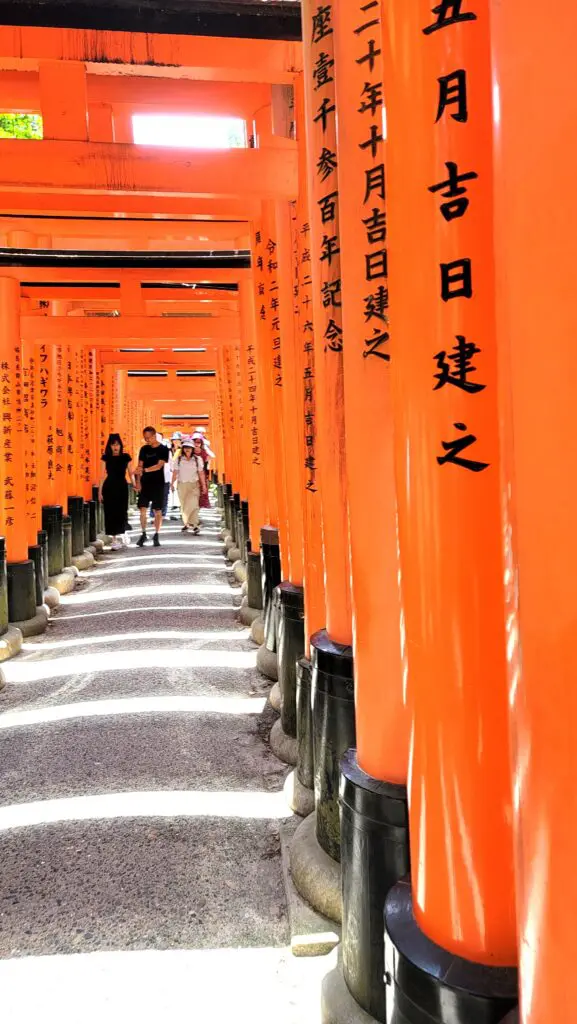
Whether you have a few hours to stroll through the gates or an entire day to hike the trails, Fushimi Inari shrine is a must-see for anyone visiting Kyoto.
As for us, we ran out of steam before we ran out of gates. And given that we were just getting started and had a lot more to see, we decided to take our tour guide up on his offer to show us a shortcut out of the trail.
Beyond the Gates
In addition to the gates themselves, we explored the beautiful grounds and buildings.
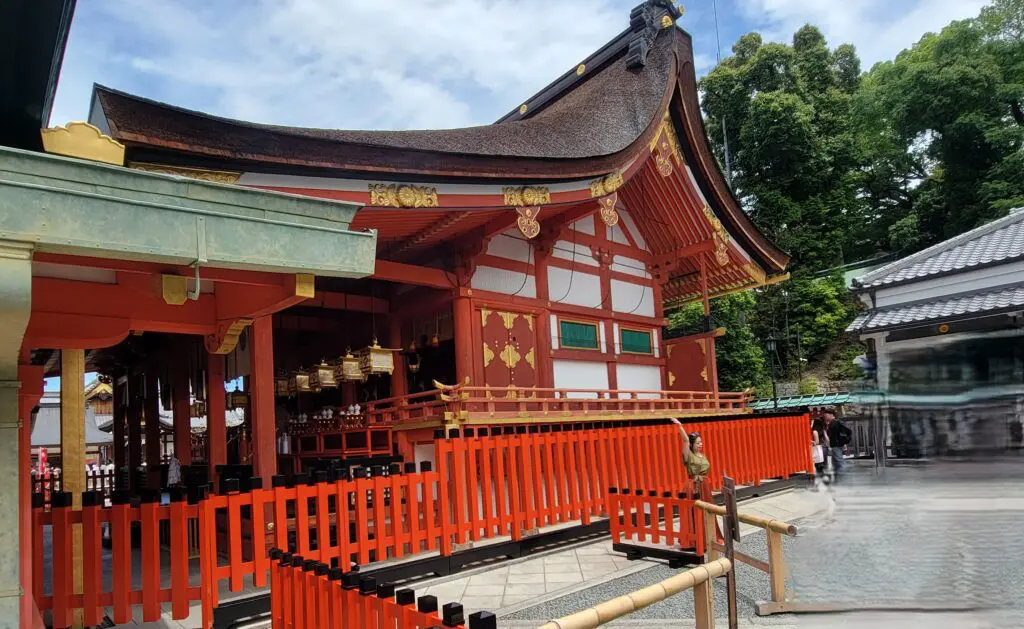
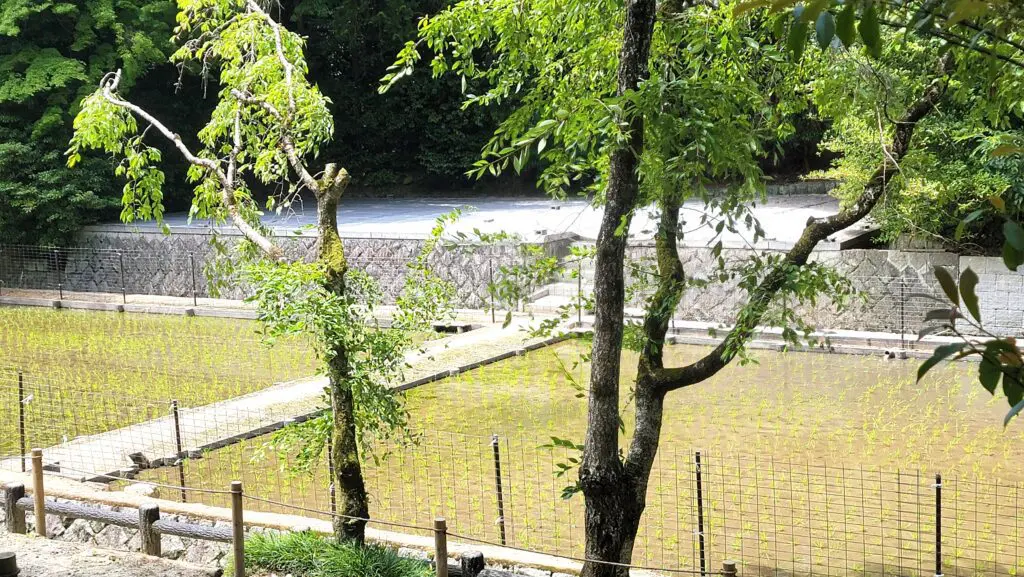
And we got lucky – while we were at the shrine, we were able to witness a traditional ceremony of thanks dedicated to certain of its benefactors. It was really special to see something so authentically old world Japanese.
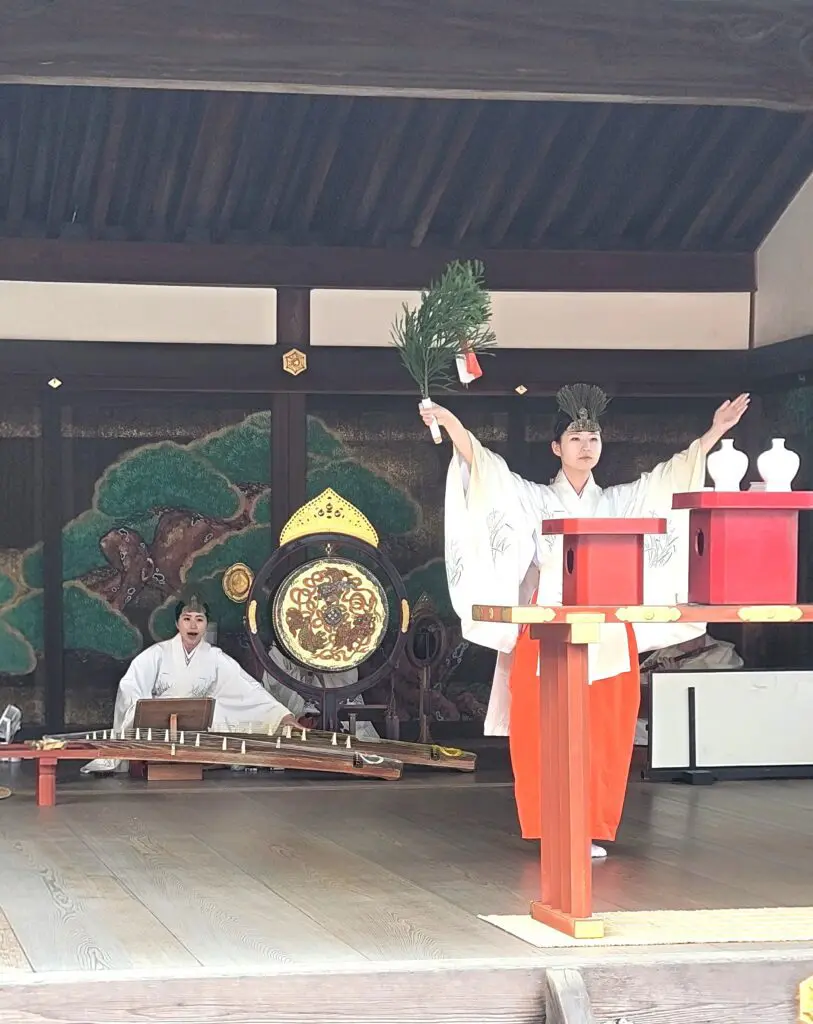
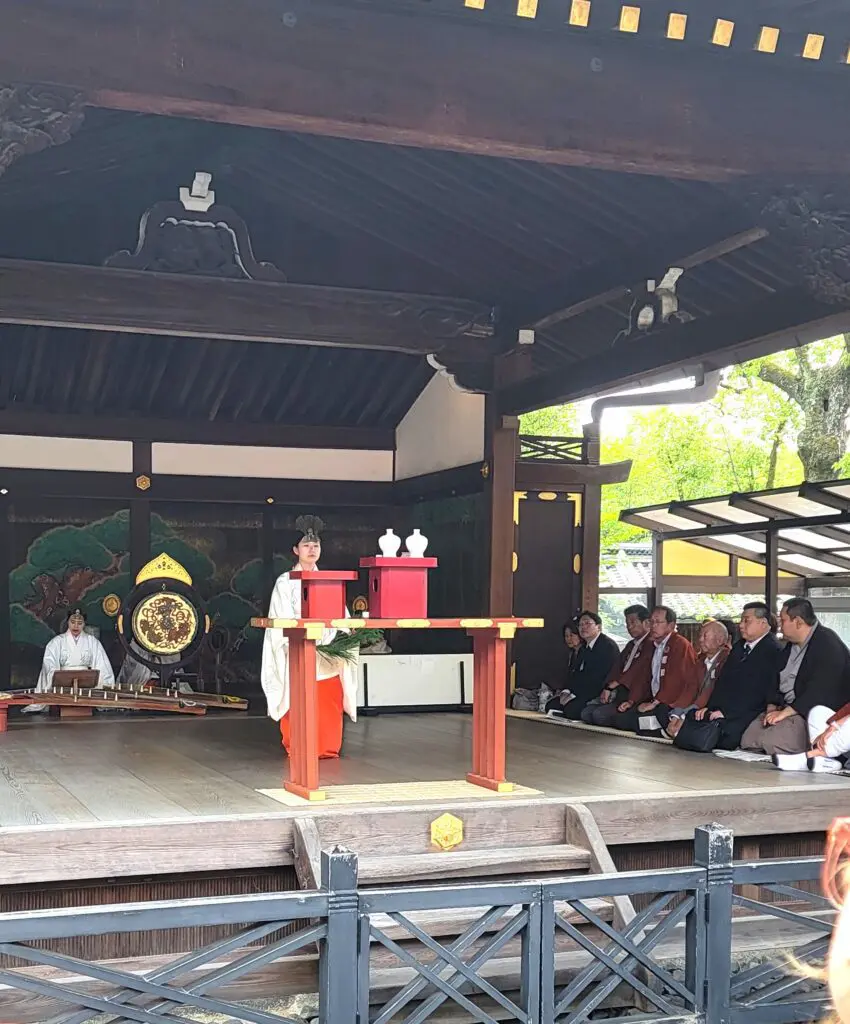
Lunchtime Delights
After exploring Fushimi Inari Taisha, we were ready to eat! We opted for a delightful lunch of authentic Kyoto cuisine in a local restaurant tucked away in a side street.
The fresh ingredients and delicate flavors had us yearning for more! Well, at least our eyes were yearning for more. Out stomachs were actually stuffed, since the portions were so large.
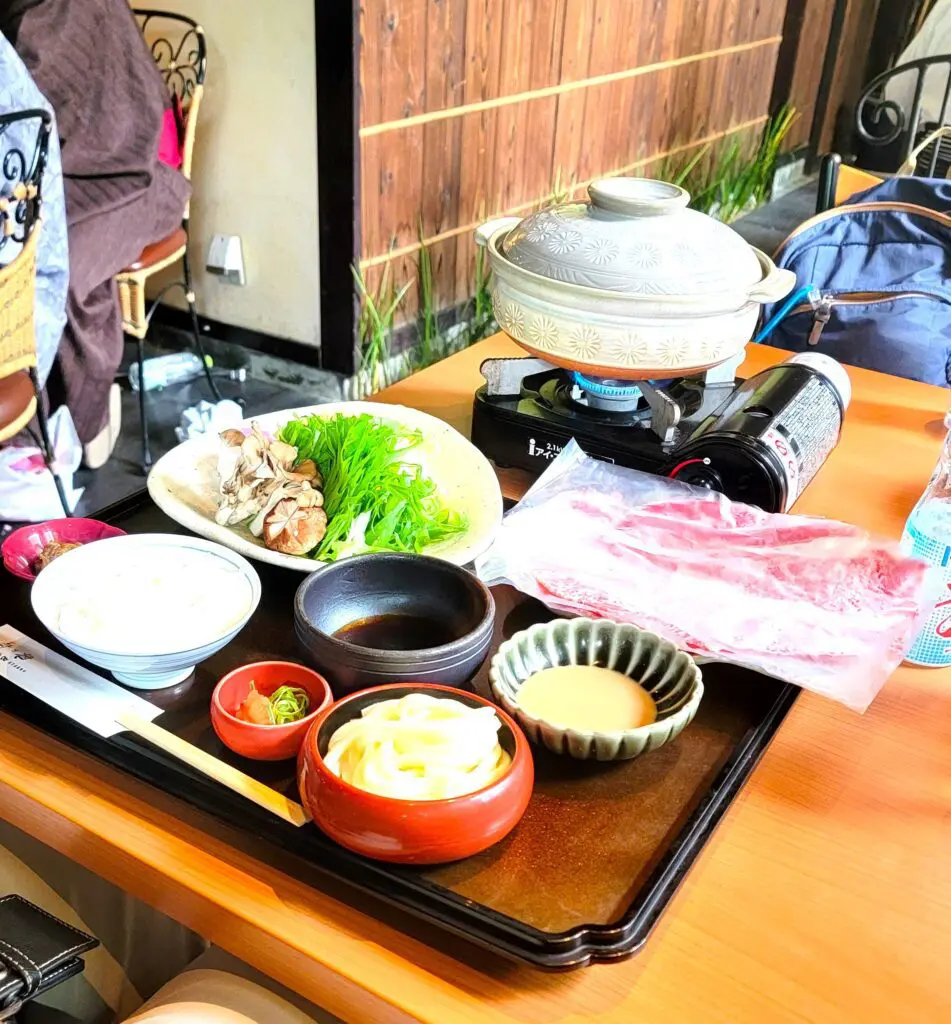
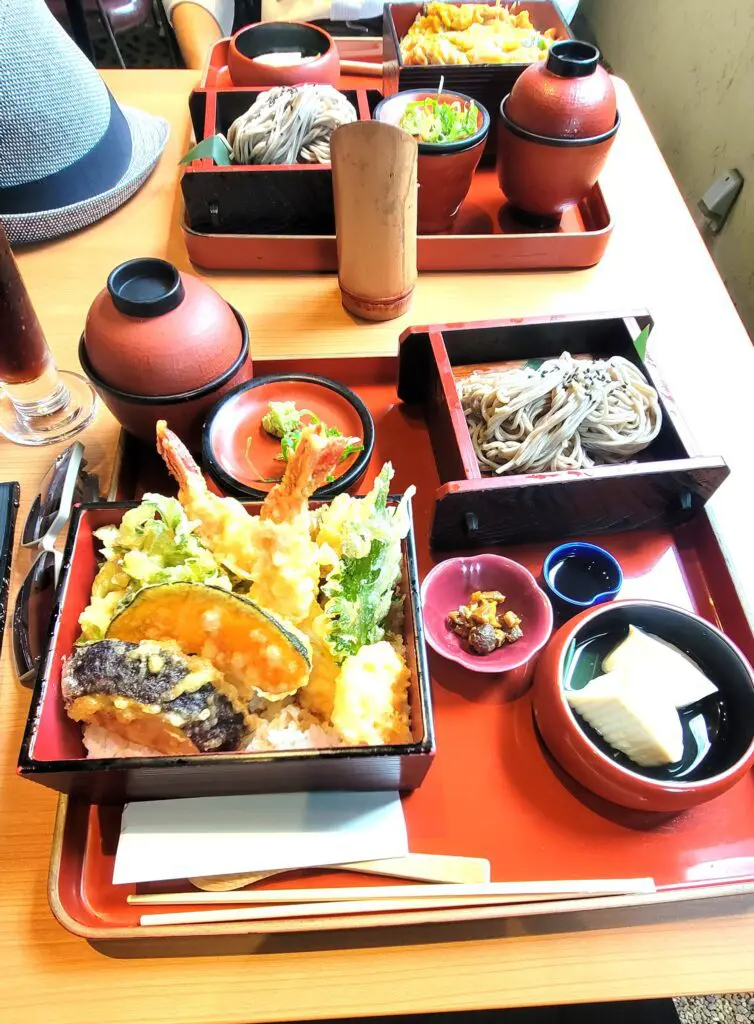
Our guide took us to one of his favorite places that was walking distance from Fushimi Inari Taisha, but there are many choices available, depending on your taste. Some excellent options include:
Yoshiya (where we went), 31 Tsukurimichi-cho Saga Tenryuji,Ukyo-ku, for a wide variety of traditional Japanese cuisine.
Vermillion, 5-31 Kaidoguchi-cho Fukakusa Fushimi-ku – for pastries and lighter meals.
Kendonya, 612-0012 Kyoto, Fushimi Ward, Fukakusa Ichinotsubocho, 41 for some of the best handmade udon noodles in the area
Arashiyama: Tranquility and Nature’s Beauty
After lunch, we had renewed energy for the rest of our adventure.
And so, we ventured into the Arashiyama district, which is known for its natural beauty. The area is also famed for it temples, stunning landscapes, and incredible bamboo garden.
First, we strolled along the picturesque Katsura River; its gentle flow truly calmed our senses.
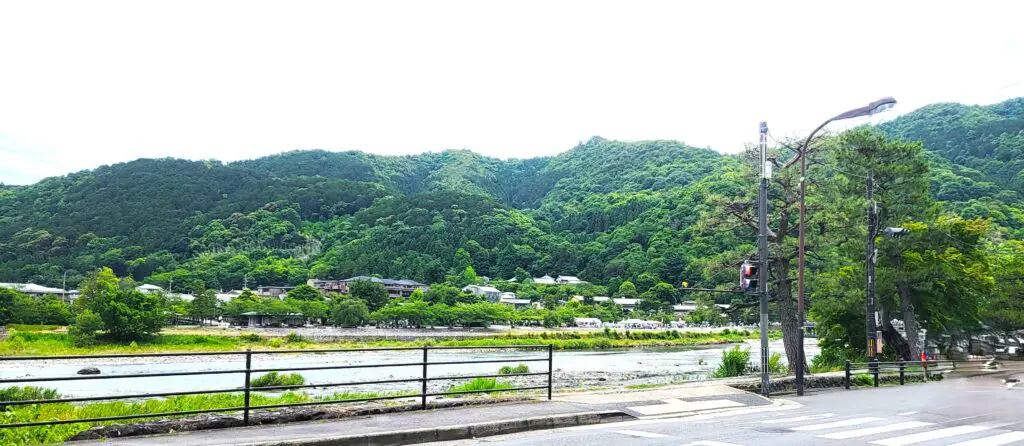
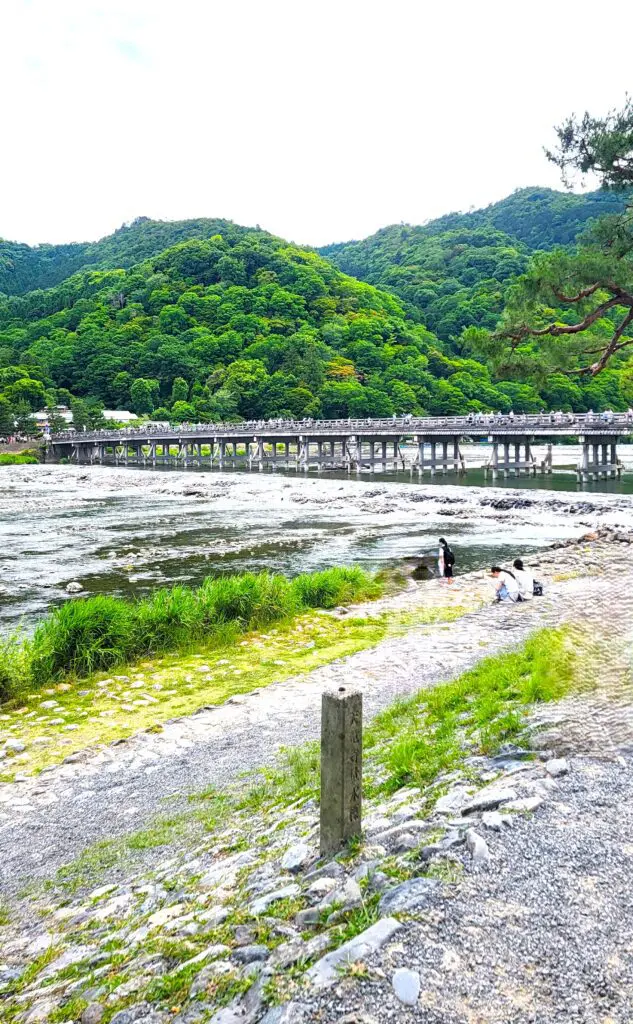
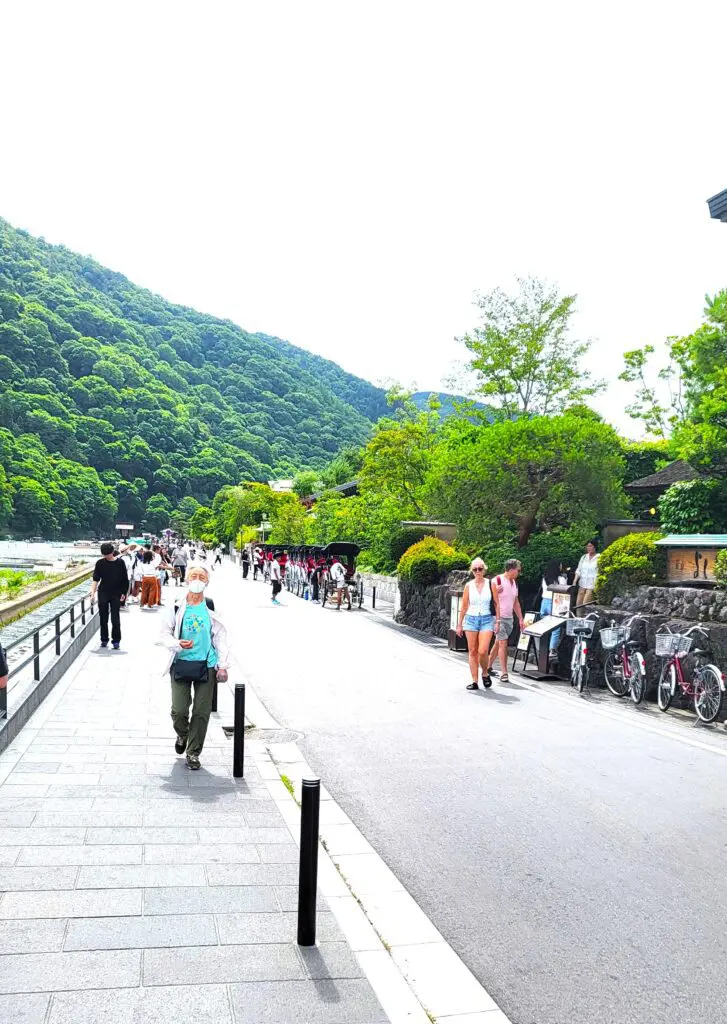
While we didn’t stop because we were keeping to a strict schedule, there were people enjoying the river in canoes. If you have the time, it looks like a really relaxing way to spend the afternoon.
Another thing we noticed was how many rickshaw operators there were in area. There were lined up along the river, ready to give an authentic experience. And what was interesting is that most of the people using the rickshaws appeared to be local people. Meaning that they didn’t appear to be there just as a novelty for visiting tourists (like us). They seemed to be truly an everyday form of transportation for people living in the area. So cool!
Tenryu-ji Temple
Our walk led us to the Tenryu-ji Temple and grounds.
As we approached the temple, we first came across an incredible garden full of buddhas.
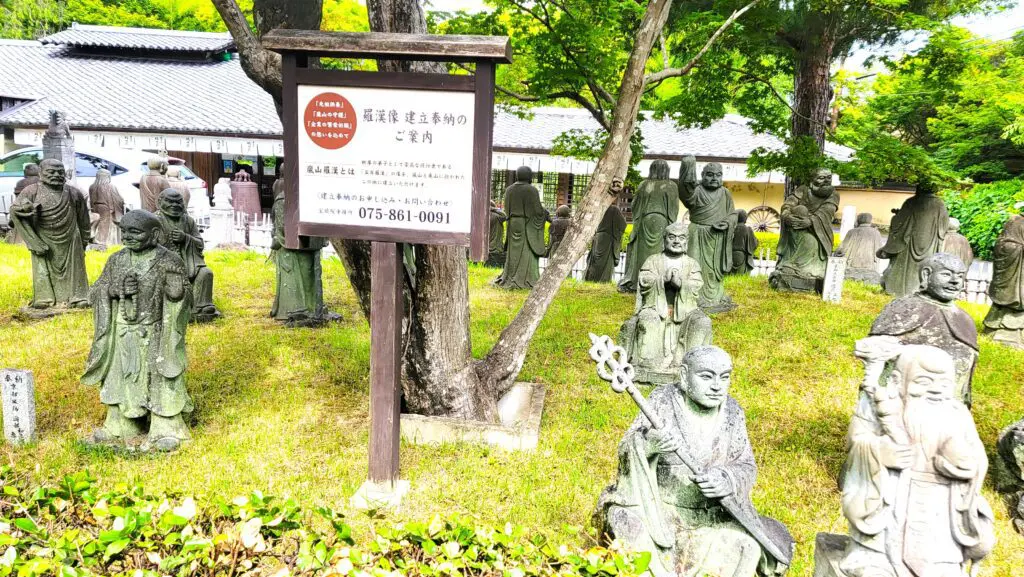
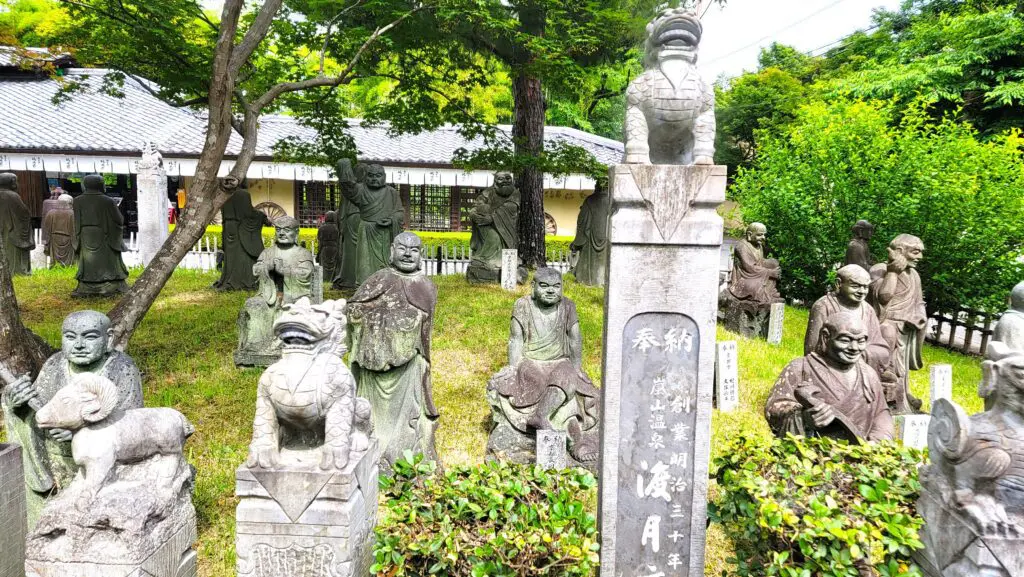
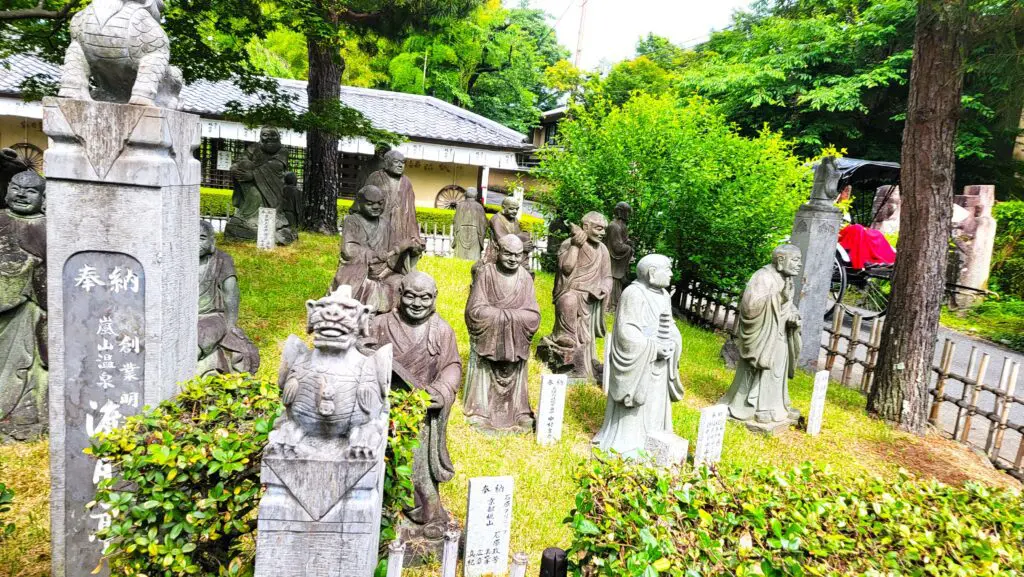
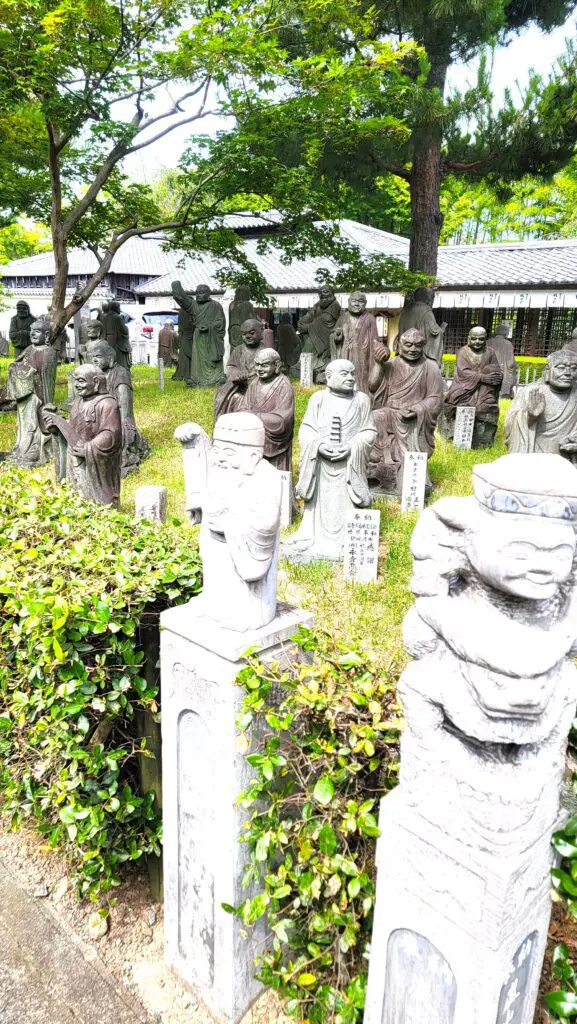
Once we saw those, we knew we were in for something very sacred.
Next, we stepped into the serene Unesco World Heritage Site founded in the 14th century, Tenryu-ji Temple.
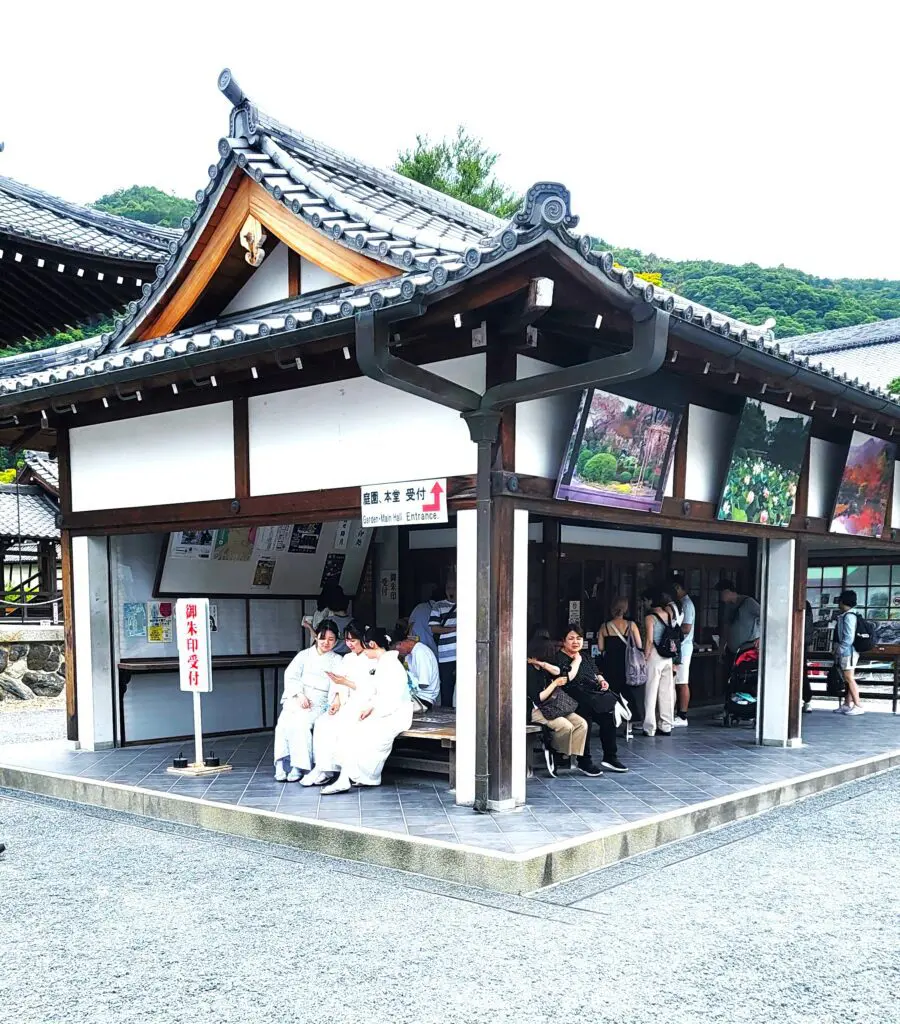
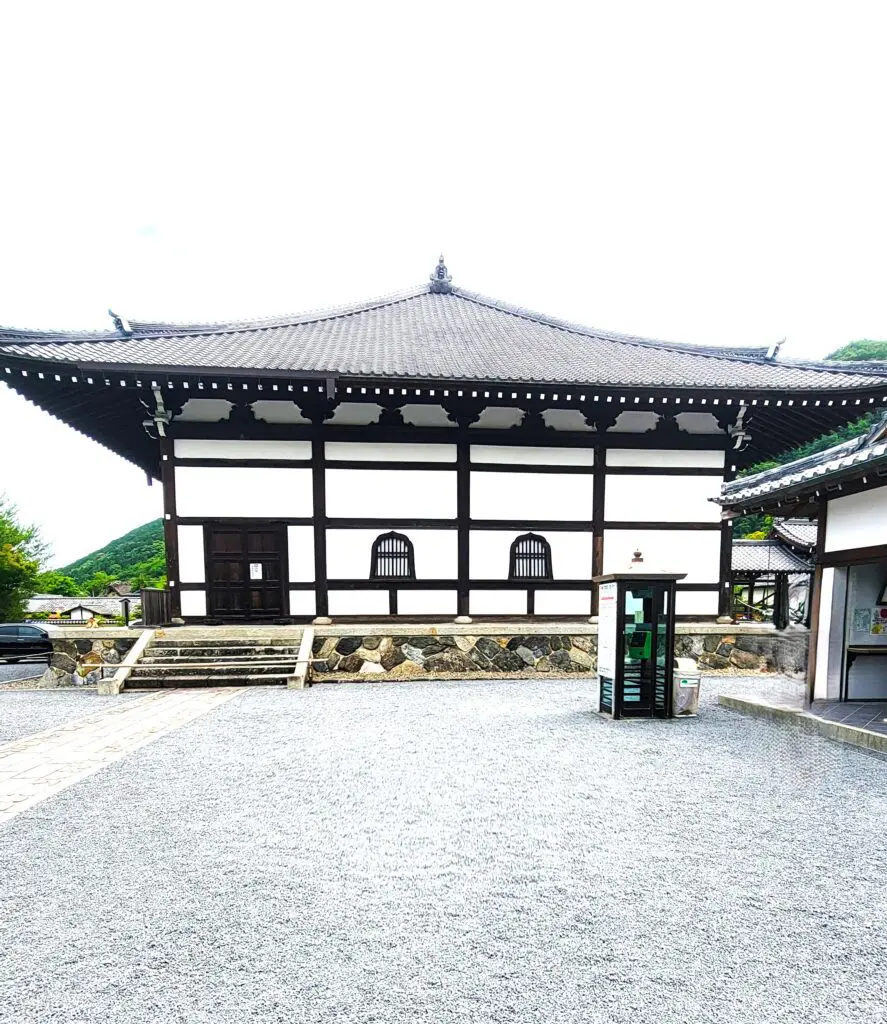
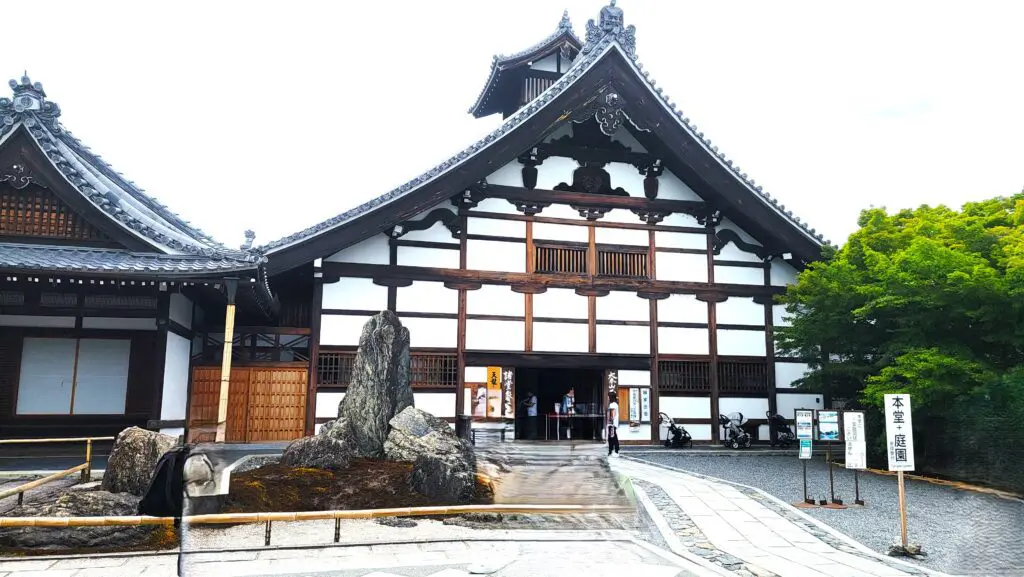
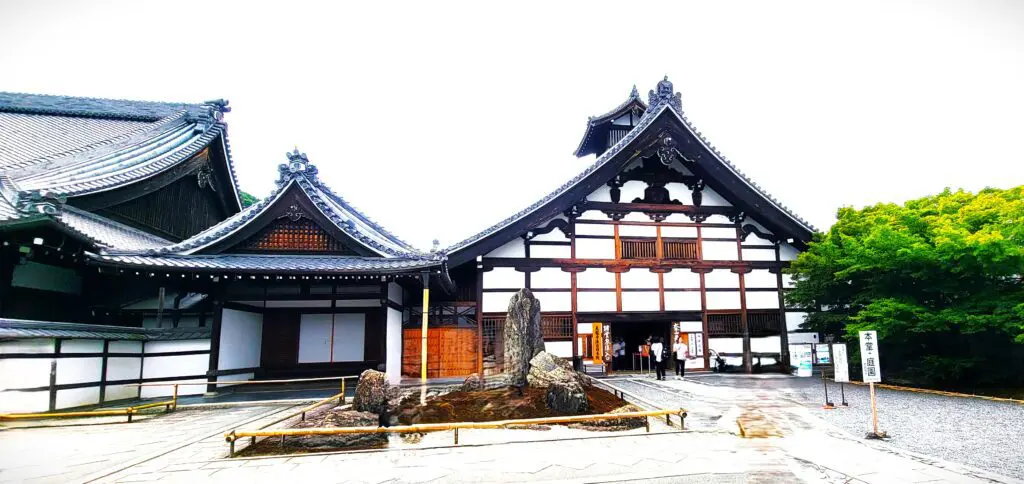
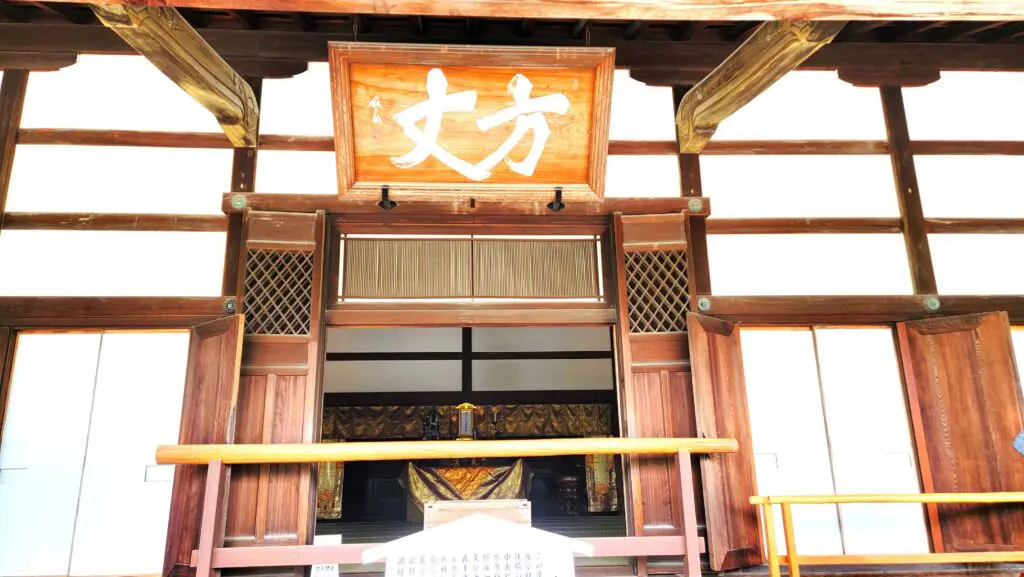
Tenryu-ji Temple is a must-visit Zen temple and UNESCO World Heritage site. Founded in 1339, it’s famous for its stunning Sogenchi Garden, designed by Muso Soseki, which beautifully blends with the surrounding mountains.
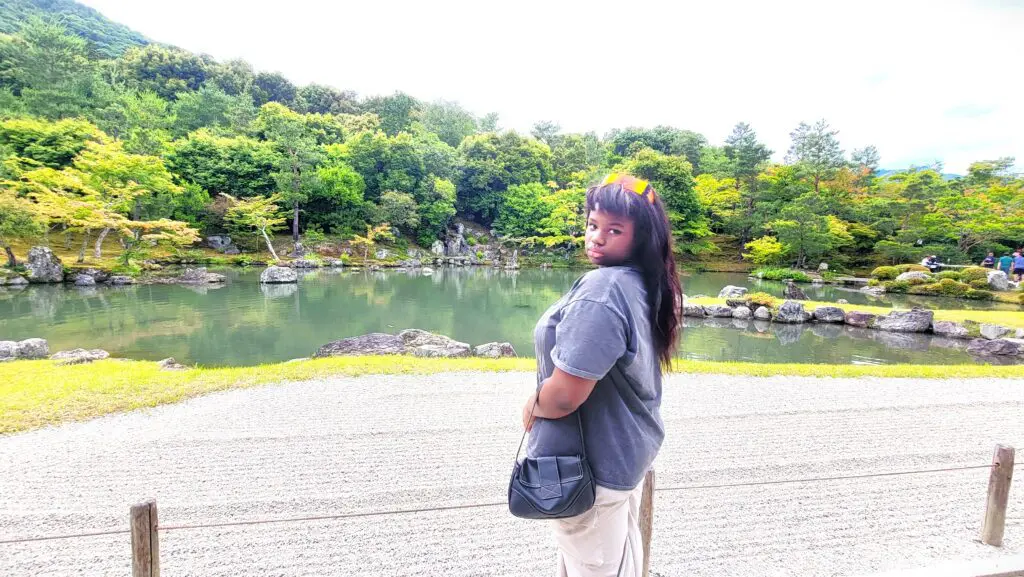
The temple’s traditional Zen architecture and rich history make it a serene retreat.
A key reason we wanted to visit was for the gardens; a walk through these invited us to slow down, breathe deeply, and appreciate the beauty of simplicity.
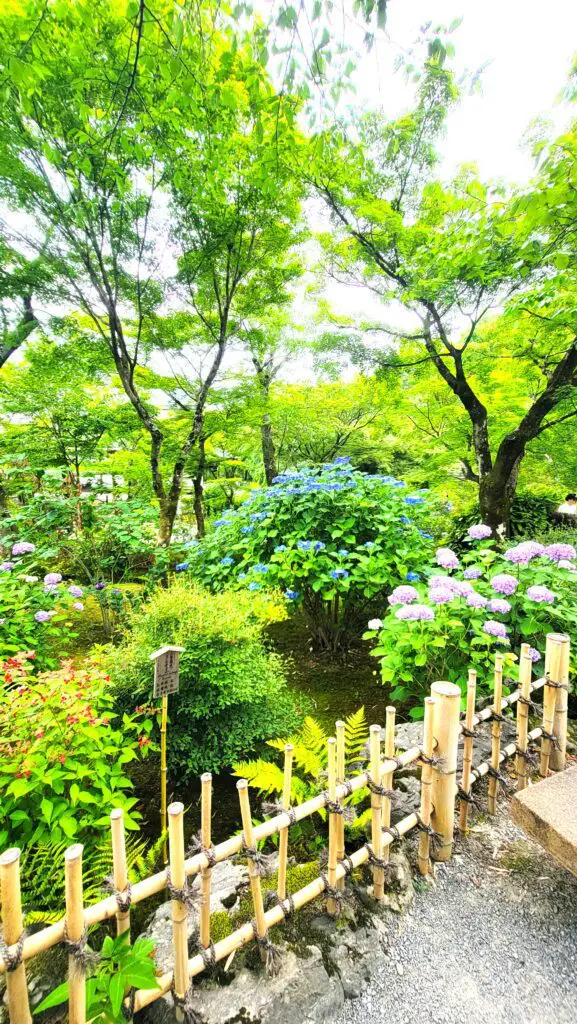
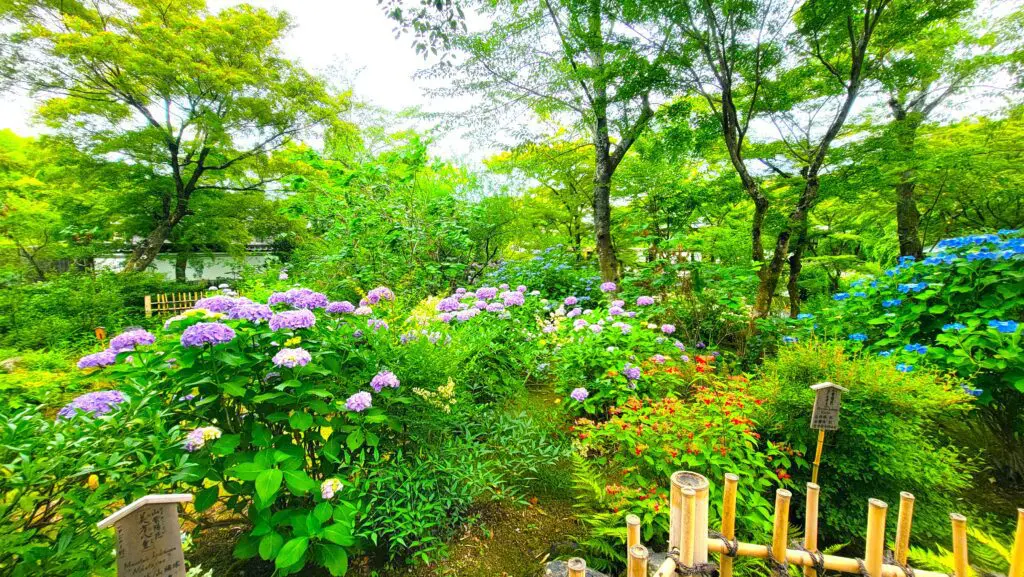
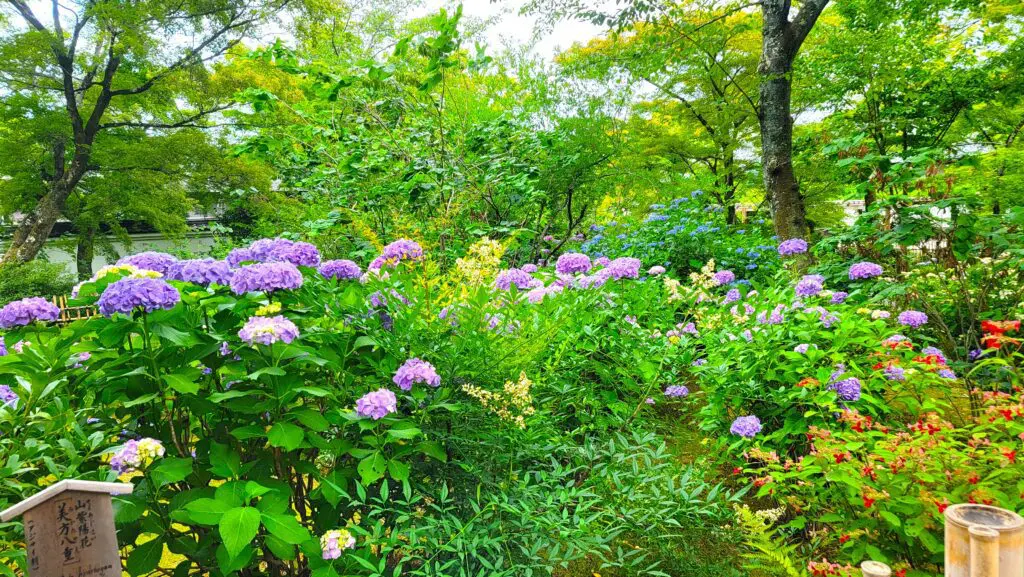
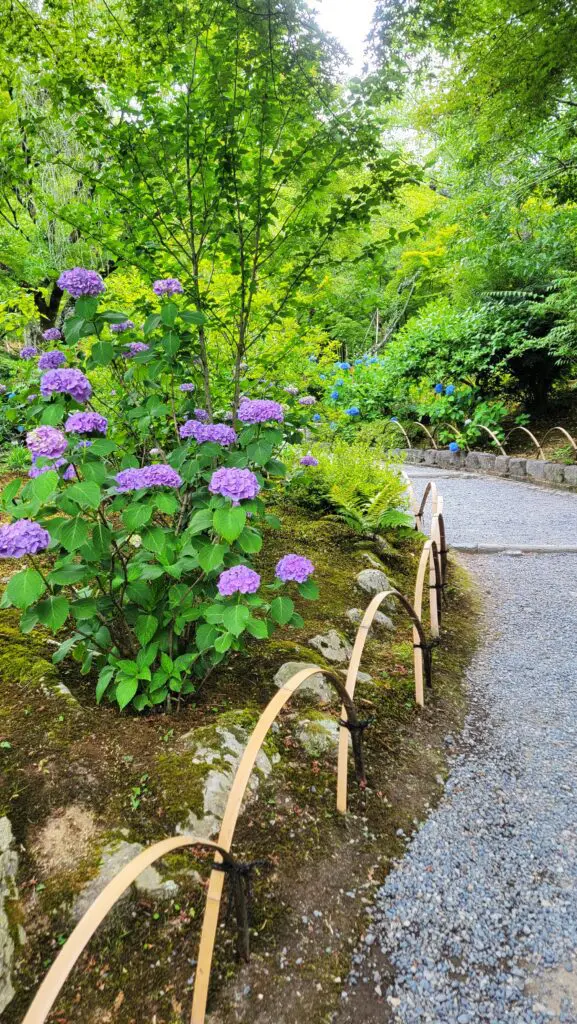
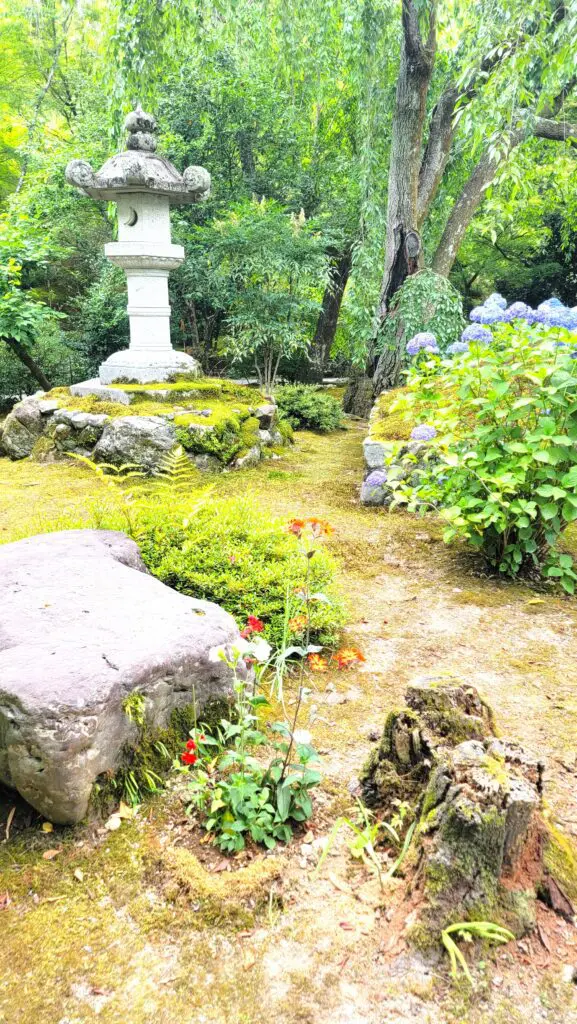
Much-needed after the vibrant energy of Fushimi Inari Taisha!
The Enchanting Bamboo Forest
No visit to Arashiyama is complete without experiencing the iconic Arashiyama bamboo grove.
And getting from Tenryu-ji Temple to the Bamboo Forest was by far the easiest part of our trip!
Once you exit the temple, you’ll be near the temple’s north gate. The Bamboo Forest is just a short walk from the temple. Head north from the temple gate, following the signs pointing towards the Bamboo Grove Path.
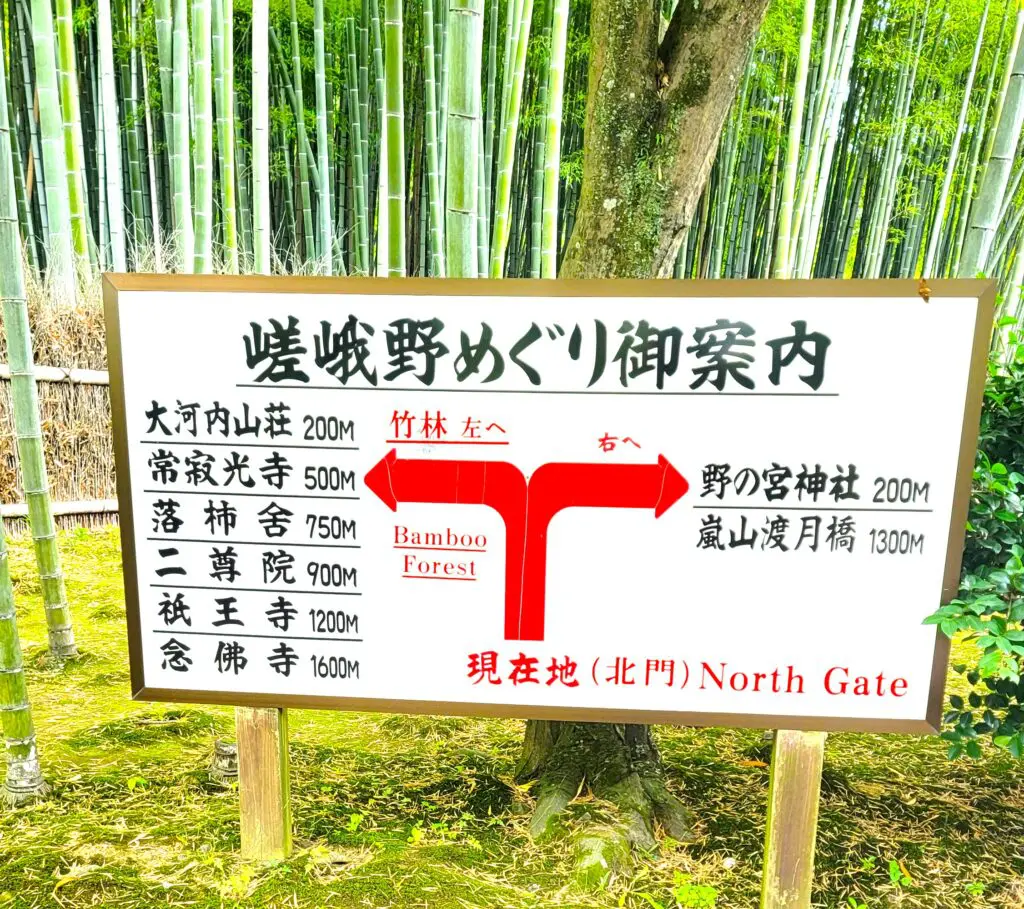
It should take about 5-10 minutes to reach the entrance.
As you walk, you’ll soon find yourself on the scenic path that winds through the towering bamboo stalks. Enjoy the peaceful and picturesque surroundings.
As you near the forest, you’ll start to see towering stalks of bamboo gently swayed through the breeze. The air was filled with a hushed quiet—and the sunlight filtering through the trees was just the perfect addition to that perfect outdoor experience.
It was actually an almost spiritual experience. Imagine being in a uniquely beautiful place surrounded by other people – and yet it still being incredibly quiet. It felt as though everyone in the forest could feel just how special it was to be there and no one wanted to break the spell.
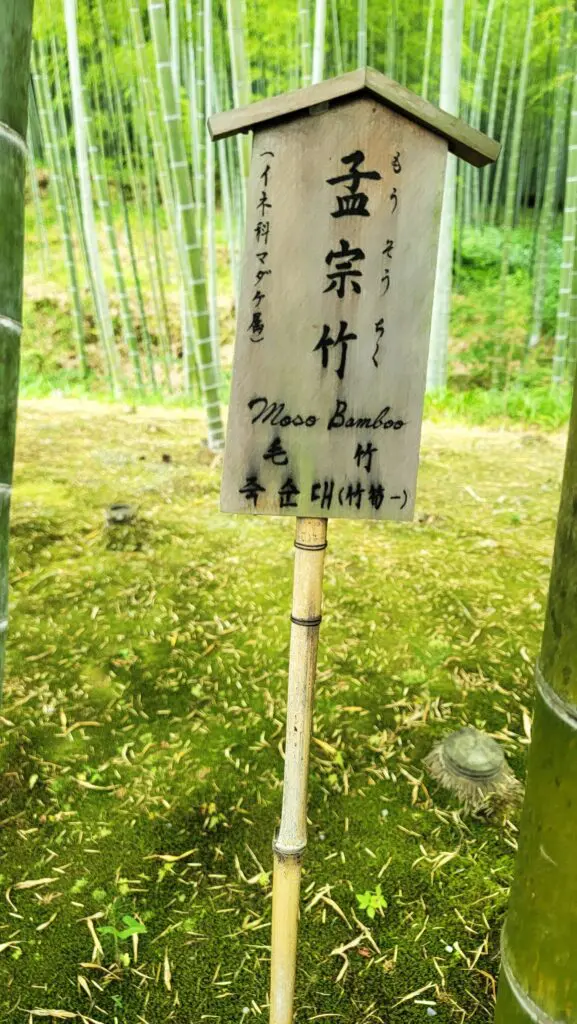
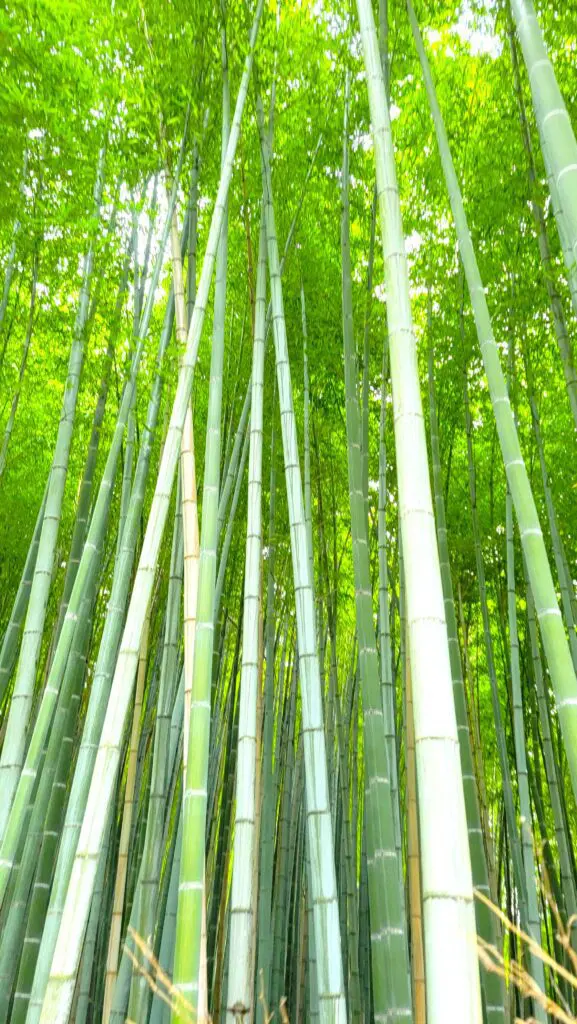
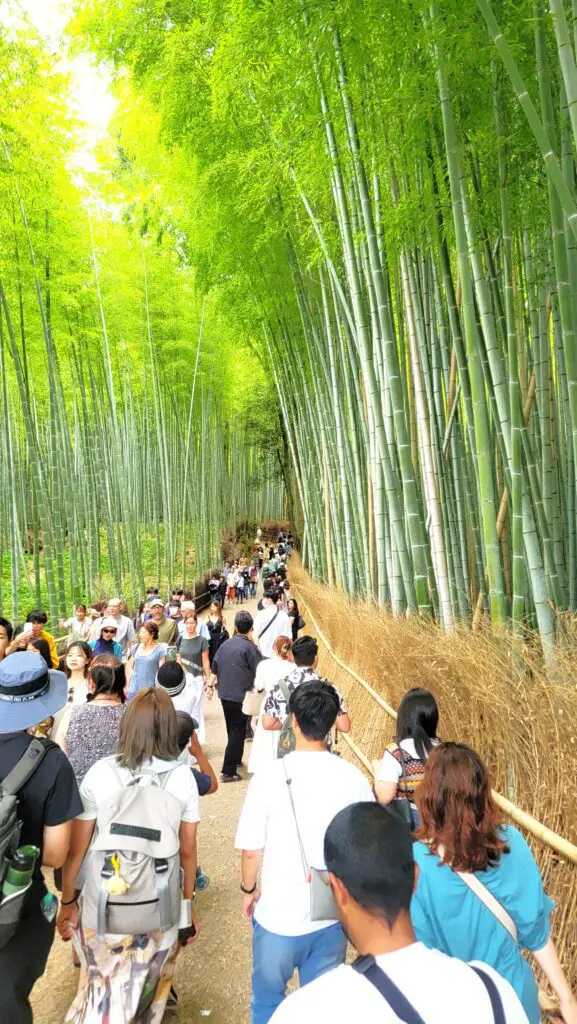
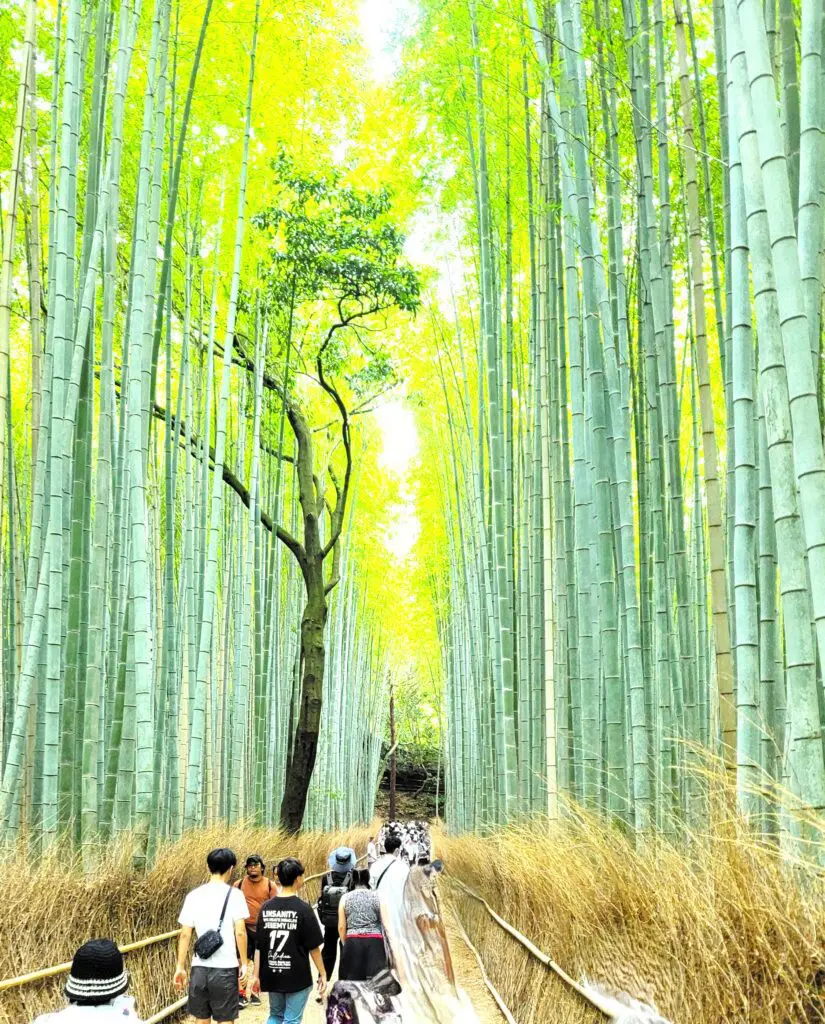
I strolled arm-in-arm with my daughter along the pathways as we marveled at the sheer excellence of the forest. It felt like stepping into another world, a world where nature reigned supreme.
We stopped to capture photos (and tried to do justice to the breathtaking beauty around us).
Before leaving the area, we decided to each buy a charm in order to make a wish for our future.
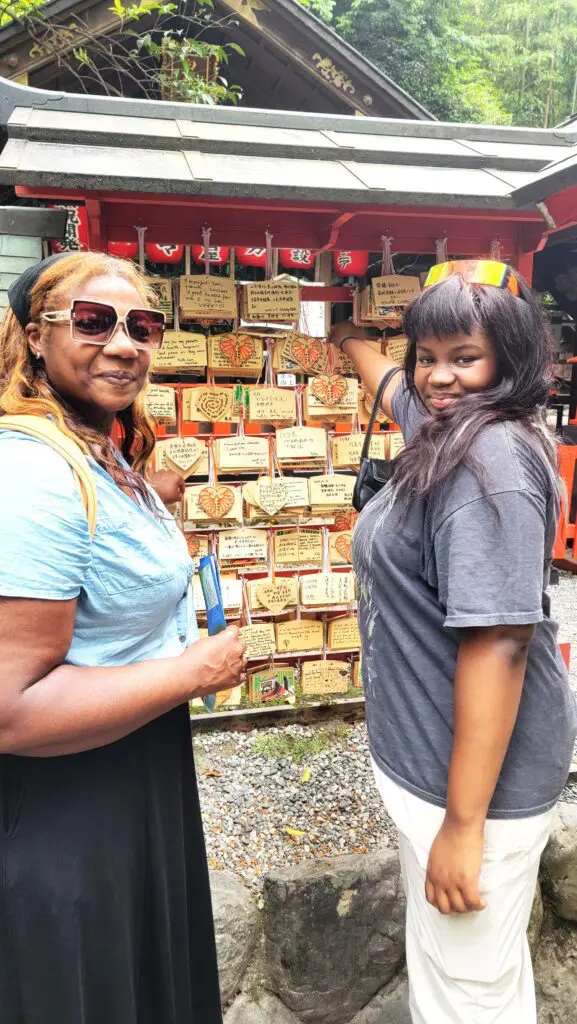
I’ll let you know if it comes true!
Golden Grandeur: Kinkaku-ji Temple
As the afternoon wore on, we took a taxi to reach the magnificent Kinkaku-ji Temple (also known as the Golden Pavilion) and grounds.
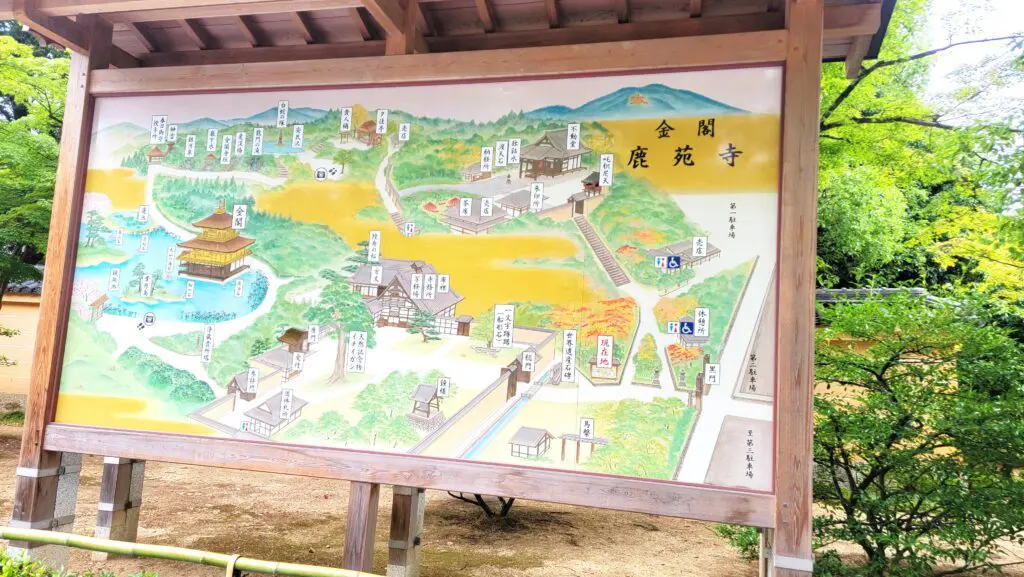
Kinkaku-ji, or the Golden Pavilion, is yet another must-see landmark in Kyoto, known for its stunning gold-leaf-covered exterior that shimmers in the sunlight. Originally built in 1397 and rebuilt in 1955, this Zen Buddhist temple sits beautifully amidst a serene Muromachi period garden, with the picturesque Kyoko-chi (Mirror Pond) reflecting its splendor.
A UNESCO World Heritage site, Kinkaku-ji offers a peaceful walking path around the pavilion, perfect for photography and quiet contemplation.
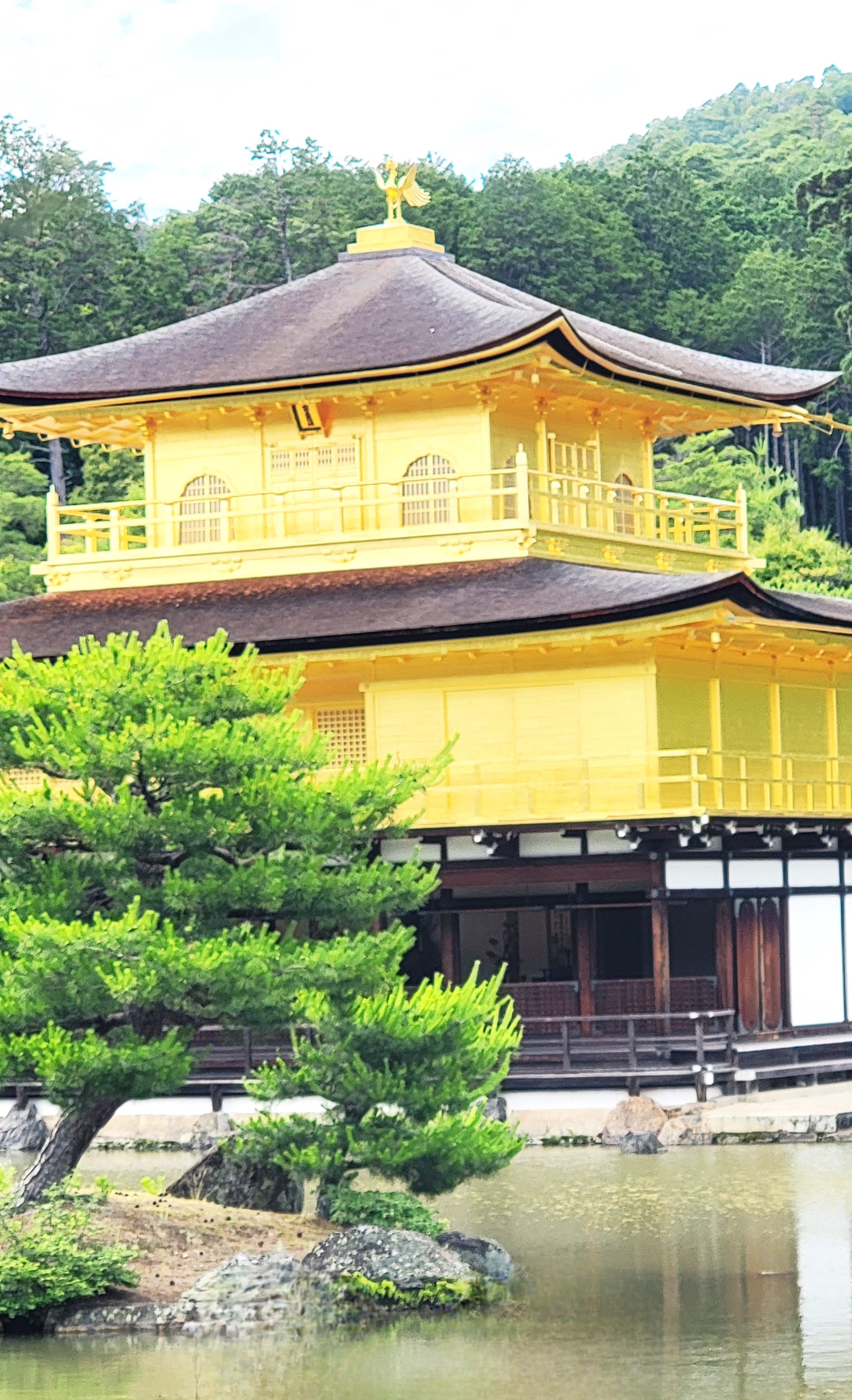
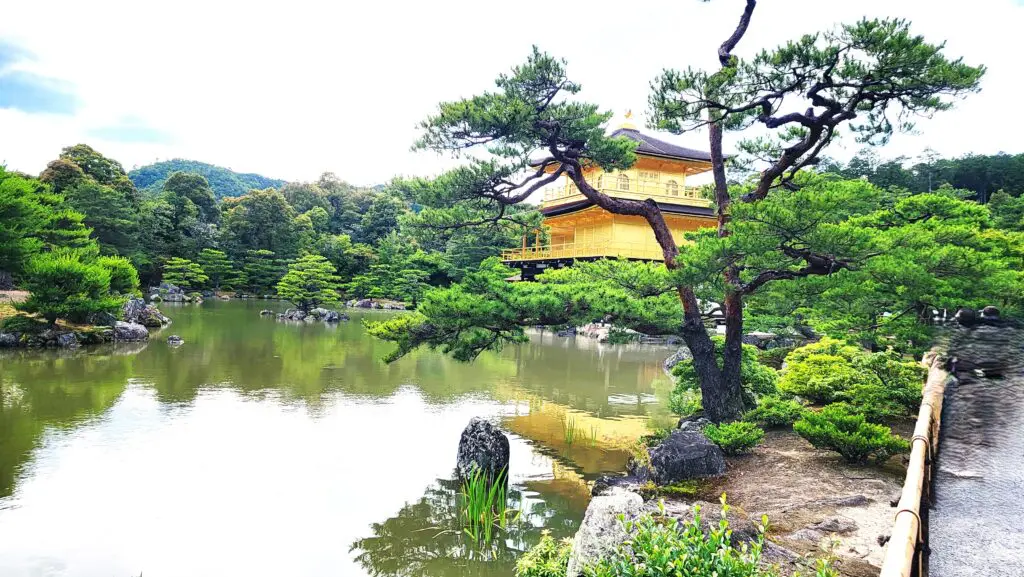
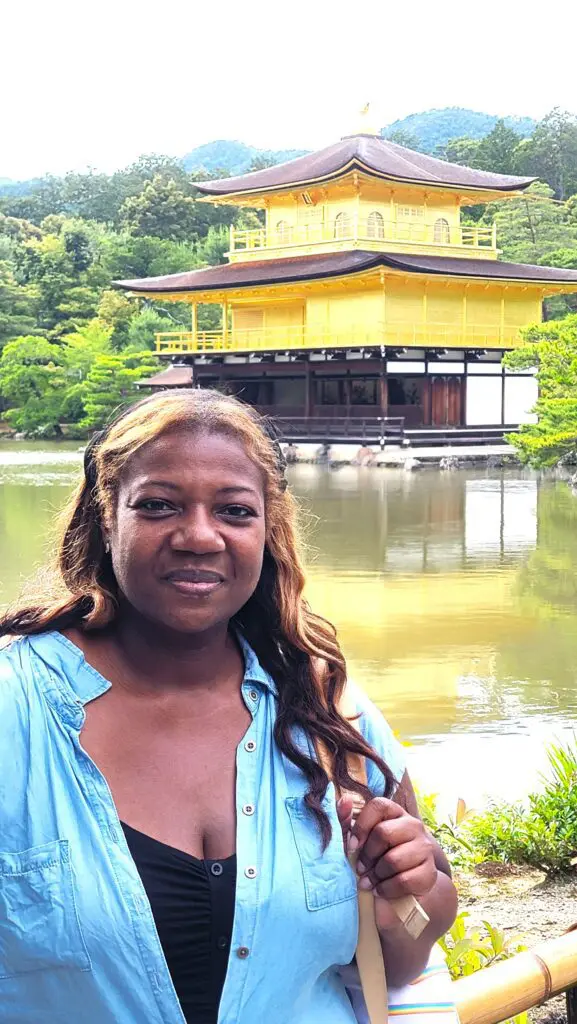
By the time we were nearing the end of our visit to the Golden Pavilion, and the end of our time in Kyoto, we were tired! We decided to make an unplanned stop for some traditional Japanese refreshments.
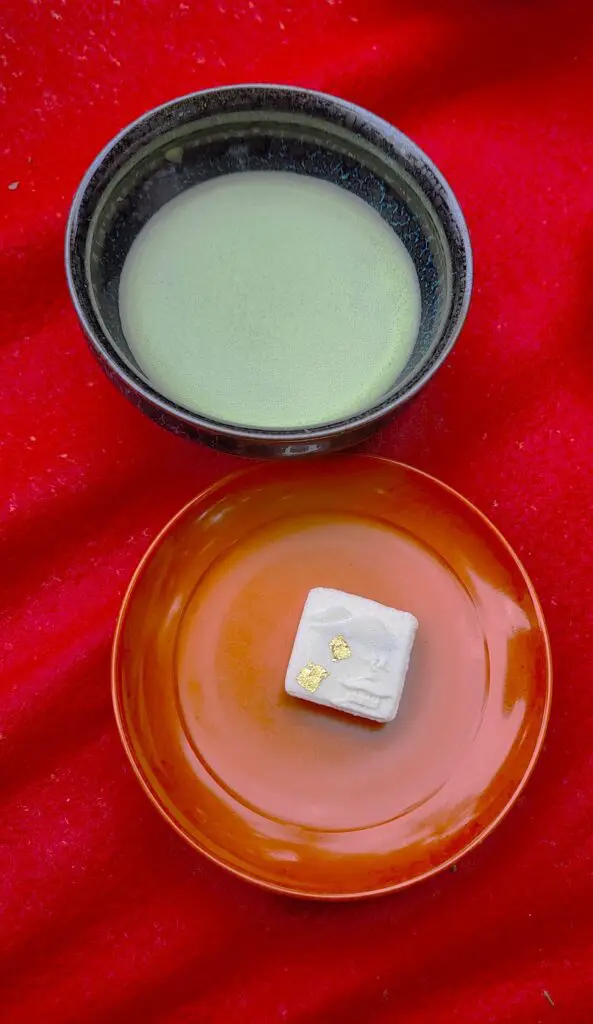
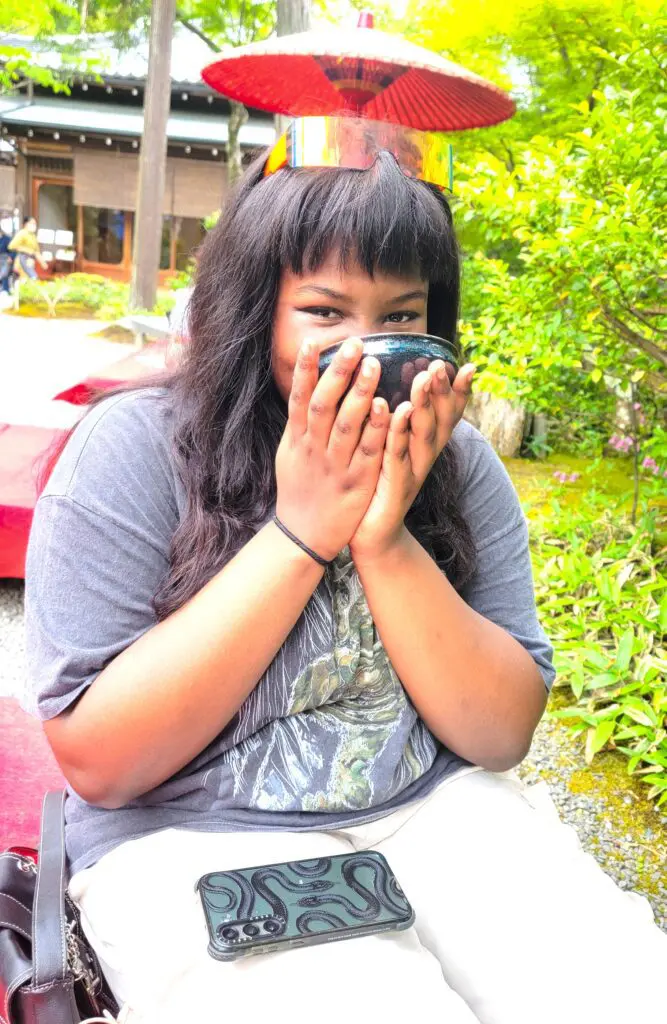
Much to my daughter’s delight!
Cold matcha and a traditional sweet tea cake. It was just what we needed to regain our energy for the last leg of our journey.
Farewell, Kyoto!
With a heavy heart but a camera full of memories, we took another taxi back to Kyoto Station. Our whirlwind day trip was drawing to a close, and it was time to catch the shinkansen back to Tokyo.
Tips for Traveling to Kyoto
- If you can, pack a refillable water bottle. We learned that because Kyoto is situated in a basin, it gets even hotter there than in some other parts of Japan. And it showed! We were sweltering during our June visit.
- Kyoto is best explored on foot, so be sure to make you wear comfy shoes.
- If you have more time than just one day, consider purchasing a multi-day travel pass for unlimited rides on buses and subways. That will save you money!
- Popular destinations, such as Fushimi Inari Taisha, can easily get crowded. So, you want to visit during the early morning hours to skip the crowd.
- Kyoto is a foodie’s paradise, and even picky eaters can find something delicious. You want to try local specialties like takoyaki (octopus dumplings) or yakitori (grilled chicken skewers) for that taste of culture.
Final Words on Our One Day Kyoto Itinerary
My daughter and I ticked Kyoto off our bucket list with a day trip, and we can’t wait to be back and experience the city at a slower pace 🤍 If you’re planning your first trip, you definitely don’t want to miss the highlights we visited. If you can fit in some more destinations, that’s a bonus 😉
Getting around Kyoto during your 1 day itinerary
If this were a regular visit to Kyoto, then I would encourage you to use the Japan Rail Pass to get around. The transportation in the area appears to be pretty good.
However, this isn’t a ‘regular’ visit to Kyoto. This is a “one day, pack in as many highlights as you can” type visit. Meaning, that the fewer minutes you are standing around waiting for a train or a bus, the better.
Many areas of the city are walkable. But if you need to get across town fast, then I recommend a taxi rather than waiting. They are everywhere, and so easy to locate.
TIP: Make sure you have the Google Translate app downloaded onto your phone to help you explain where you want to go – in case your driver doesn’t speak English. While we were there, we found that some of our drivers already had Google Translate, but better to have it yourself just in case.
Is one day in Kyoto enough?
Of course, you can’t see ALL there is to see in Kyoto in one day. There is just way too much cultural goodness packed into those 319 square miles to see it all in one day – especially since so much of the city is best explored on foot. But, if you do have a full day to dedicate to it, it’s definitely worth the visit. Especially for a first time visitor to Japan.
As you can see from our Kyoto one day itinerary, a full day allows you to hit several of the highlights and really experience the natural beauty and tradition of this incredible city. If you are visiting from a major city (like we were, as we were based in Tokyo during our visit), Kyoto allows you to experience a part of Japan with a completely different vibe.
Is a day trip from Osaka to Kyoto worth it?
In short, yes! Unlike the trip from Tokyo to Kyoto, the trip from Osaka to Kyoto is literally a hop, skip and jump away. You can get to Kyoto in 40 minutes or less, depending on how you choose to travel. Which means that you can see sooo much more in one day.
Plus, despite the two cities being so close together, they have different feels. Osaka has a much more vibrant urban feel than Kyoto. Kyoto is where you will get your infusion of truly traditional Japan. If you have a day to spare, adding Kyoto to the itinerary is absolutely worth it.

